- National Turists
- Our Campings
- Our Mountain Hostels
- Torres del Paine

W Classic Circuit
Welcome to the most famous trekking in torres del paine, accommodation options.
- Mountain Hostel
- Mix Hotel Las Torres / Mountain Hostel
Home » Circuitos de Trekking » W Classic Circuit
One of the best hikes in the world
The W Circuit will make you to fall in love with Chile’s Patagonia. The pictures speak for themselves but could never do justice to the sights, feelings, excitement and pure awe that you will experience while hiking the W Circuit. Hiking through unbelievably big mountains, deep valleys, and dense, mysterious forests will leave you grateful for life and the exact moment you’re living.
The W Circuit is the most popular hike in Torres del Paine National Park for a reason – it’s stocked with all the highlights including Las Torres Base Viewpoint, Los Cuernos Mountains, Francés Valley, Paine Grande and Grey Glacier .
You can choose your adventure style, from camping immersed in nature to full room and board in shared mountain hostels or private hotel rooms. While still remaining a physically and mentally demanding experience, the W Circuit offers luxuries like comfy beds, hot showers, warm, hearty meals, and stock-up points along the way.
The W Circuit gets its name from the way it starts at one end of the Park, winds up and back down two spectacular mountain valleys, and then comes to a close at the other end, forming a W from a bird’s eye view.
The 5 day/4 night W Circuit option gives you the first day to relax and thoroughly explore the numerous sights of the Las Torres sector.
Amongst the most famous mountains in the world, these three towering, granite peaks soar in the blue sky at 2850m / 9350ft, 2800m / 9200ft, and 2600m / 8500ft. Molded by pure glacial force, these are the breath-taking towers that give the Park its name.
Los Cuernos
These three mountains put up a fight with the Las Torres Mountains over prettiest in the Park. Standing at 2600m / 8500ft, 2400m / 7900ft and 2200m / 7200ft, the different types of rocks that make up this massif create a stark, beautiful, and multi-colored contrast. A 700m / 3000ft wide slab of granite crosses the middle of these uniquely shaped mountains.
Francés Valley
This lookout in the middle of the W Circuit boasts unmatchable views. To the west, you can gaze at the Cuernos, Espada, Hoja and Máscara mountains. To the east, the Francés Glacier overhangs Mount Paine Grande. To the north, the jagged Fortaleza and Aleta de Tiburón (shark’s fin) peaks stand out against the sky. As if that wasn’t enough, the valley is immersed in a Nothofagus forest filled with many species of trees and vegetation that produce a variety of flowers and change colors during autumn.
Paine Grande
Made up of four summits, Paine Grande is recognized as one of the most beautiful mountains in the world. The highest peak towers at 3050m / 10000ft, making it the tallest mountain in the Macizo Paine Range and also the technically hardest mountain to climb in the entire Torres del Paine National Park.
Glaciar Grey
This is the largest glacier in Torres del Paine National Park, measuring 6km / 4mi wide, 30m / 100ft tall and 19km / 12mi long. Its floating icebergs and glacial moraines are just as picturesque as the glacier itself, which tumbles down from the massive Southern Ice Field. To see this gorgeous ice formation up close, you can take a boat ride, a kayak tour or an ice-hiking excurision.
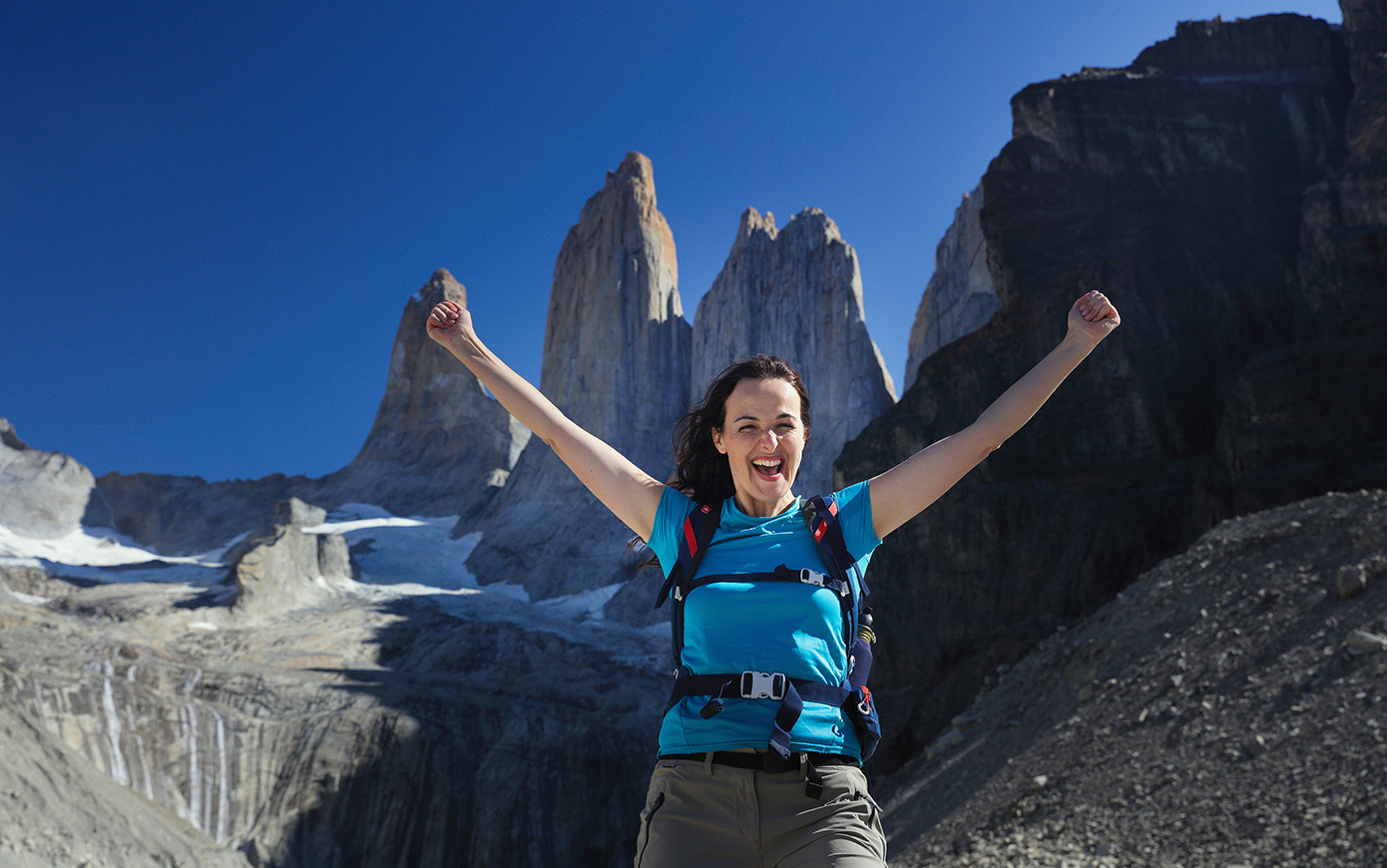
How is the Circuit?
5 days/ 4 nights. The most popular circuit in Torres del Paine will surprise you with the Torres Base Viewpoint, Los Cuernos, Valle del Francés, Paine Grande and the Gray Glacier. Options: independent self-guided, group self-guided or private guide.
What does it include?
- Premium Camping - Fully Equipped
- RESERVATION AND CANCELLATION POLICY
Premium Camping - Fully Equipped Experience
Day 1: Transportation from Puerto Natales to Torres del Paine, lodging at Central Sector. Day 2: Hike to Las Torres Base, lodging at Central Sector. Day 3: Hiking to Francés Sector (o Cuernos), lodging Francés Sector (o Cuernos). Day 4: Hike to the Francés Valley, lodging at Paine Grande Sector. Day 5: Hike to Grey Glaciar Lookout Point, then cross Pehoe Lake in catamaran* and take transport back to Puerto Natales.
Based on double occupancy – 2 people, 1 tent:
- USD $ 1,300 p/p
Single Suplement:
- 1 5 day Epic Trekking Circuit
- 2 4 nights in Fully Equipped Camping (Tent, sleeping bag, and sleeping mat)
- 3 All Meals (During Christmas Eve and New Years Eve an extra of USD $45 is charged per dinner)
- 4 Regular transport to and from Puerto Natales to Torres del Paine National Park
- 5 Catamaran from Paine Grande (May be subject to changes, which could include modifications in the itinerary, in that case we will help you find the best alternative)
- 6 Park Entrance Fee
- 7 A hike of a lifetime
Mountain Hostel Experience
Day 1: Transportation from Puerto Natales to Torres del Paine, lodging at Central Sector. Day 2: Hike to Las Torres Base, lodging at Central Sector. Day 3: Hiking to Francés Sector (o Cuernos), lodging Francés Sector (o Cuernos). Day 4: Hike to the Francés Valley, lodging at Paine Grande Sector. Day 5: Hike to Grey Glaciar Lookout Point, then cross the Pehoe Lake in catamaran* and take transport back to Puerto Natales.
Prices are per person based on 6 or 8 people per shared room:
- USD $ 1,640 p/p
During Christmas Eve and New Years Eve an extra of USD $45 is charged per dinner.
*Lake Pehoé catamaran may be subject to changes, which could include modifications in the itinerary, in that case we will help you find the best alternative
- 2 4 nights in a Mountain Hostel for 6 to 8 people
- The published rates and dates are valid from October 2024 until april 2025.
- If you would like this option with a group, please book through the form at the bottom of this page.
- Food service is limited in capacity
- If you wish to book this program with a private guide, complete the form at the bottom of this page.
- Prices in USD are for foreign tourists only.
- If you would like to read our Reservation and Cancelation Policy please click here .
- Lake Pehoé catamaran may be subject to changes, which could include modifications in the itinerary, in that case we will help you find the best alternative

Make an inquiry or a Reservation Here
Other circuits you might be interested in, las torres base circuit 3d/2n from $825 usd, w circuit express from usd $1,040.

The Ultimate Guide to Hiking the ‘W’ Trek in Torres del Paine Without A Tour
By Author Steph Dyson
Posted on Last updated: 4th September 2024
Hiking the W in Chilean Patagonia’s Torres del Paine National Park is one of the absolute highlights of a visit to Patagonia – I should know, I’ve done it twice!
Back in March 2016, I walked the Torres del Paine W trek as part of a tour around Patagonia and was so struck by the park that I returned in March 2017 to hike the Full O Circuit .
In September 2022, I returned on a third occasion, this time to explore the other attractions of Torres del Paine National Park beyond these two, multi-day hikes.
It’s fair to say that on all occasions I have fallen head over heels in love with this part of Chilean Patagonia.
The problem is, the first time I hiked the W trek in Patagonia, I did so as part of a guided tour. We were dropped off at the Pudeto ferry port on Lake Pehoé and from that point onwards barely even had to think for ourselves.
We hiked the W during the day led along the one path by our guides and arrived at night to pre-pitched tents and pre-paid food.
However, it didn’t take more than five minutes of being in the park to realize that a tour was utterly unnecessary and that trekking in Torres del Paine solo and self-guided is easy and will also save you a whole stash of money.
Click to navigate this article:
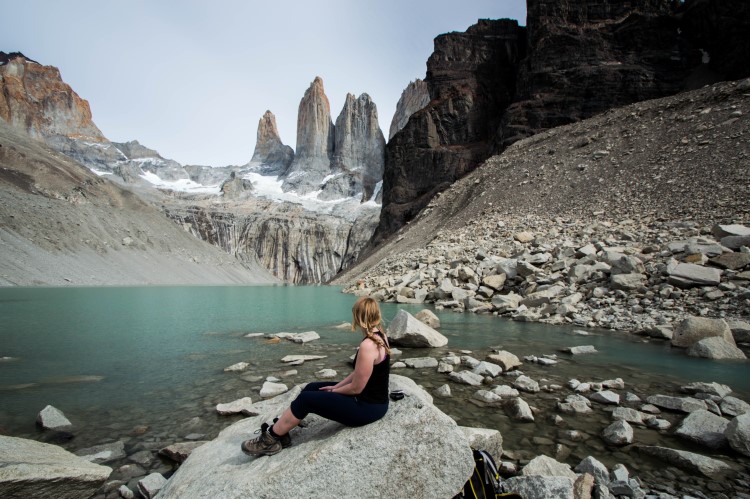
Know-before-you-go facts about the Torres del Paine W Trek
- How long is the W trek in Torres del Paine? It’s an 80-kilometer (50-mile) hike that most do over four or five days.
- When can you hike the W trek? The park is open year-round, however, for self-guided trekking, you can only hike between October and the end of April. If you want to hike during the winter months (May through September), you’ll need to arrange a guide. Our local partner, Chile Nativo, lead winter tours of the W trek and offer a 5% discount to Worldly Adventurer readers (use “Worldly Adventurer” in the referral discount box when you book!).
- Do you need to reserve camping spots/dormitory accommodation in advance of hiking the W? Yes, you must have reservations at each of the campgrounds or dormitories in which you plan to stay during the hike. You might be required to show your reservations when you enter the park, too.
- What about food? You can reserve full board at the campgrounds, which will include an evening meal, breakfast the day after your stay, and a packed lunch for you to take to the next campground. This typically needs to be booked in advance, although if you get to the campground early enough, you can sometimes do it on the day. Some campgrounds offer buffet dining (Grey and Paine Grande), so can be a good place to stock up on some snacks for the following day.
- Are reservations open for the campgrounds and dormitories along the W trek for the 2023/2024 season? Yes, reservations opened in July.
- How fit do you need to be to hike the W trek? While previous backpacking experience is not necessary, you do need a reasonable level of fitness to be able to climb up into the Frances Valley and up to the towers themselves. It’s helpful to have done a couple of practice walks, with a backpack weighing around 10 kilograms (22 pounds), in preparation for the trail.
- Do you need to book your park entrance ticket in advance? You must book online as they are no longer accept payments at the park entrance. Book your ticket online here . You need to download the QR code in Puerto Natales while you have internet (there is no signal in the park) and may need to show a copy of your passport to prove you do not live in Chile.
- How much does it cost to enter Torres del Paine National Park? The cost of entering the park varies according to how long you plan on staying. For up to three days in the national park, it costs $31,200 CLP ($34 USD) for adults and $16,000 CLP ($17 USD) for children aged 12 to 17. For over three days in the park, the cost is $44,500 CLP ($48 USD) for both adults and children.
- What is the altitude of Torres del Paine National Park? The highest point in the park is the John Gardner Pass at an altitude of 1,200 meters (3,900 feet) above sea level. However, only those trekking the O Circuit are required to reach this height; all of the W trek is at altitudes below this.
Firstly though, what actually is the W? The W is a four- or five-day hike in Chilean Patagonia’s Torres del Paine National Park. It’s named the W because it follows a W-shaped route and can be hiked either from west to east (my preferred route) or from east to west.
Along the way, you stay overnight in official campgrounds, which also have indoor dormitories, covered cooking areas for campers, and restaurants where you can eat pre-ordered meals.
Is the W worth it, though? It’s one of Patagonia’s easiest multi-day hikes and, while hiking for five days might not be at the top of everyone’s to-do list, the scenery in Torres del Paine National Park makes up for the hard work! Every day has spellbinding views: whether of Grey Glacier on day one, the French Valley on day two or three, or the eponymous towers on the final day of the hike.
You’ll finish tired but truly fulfilled by the experience – and proud of yourself for having completed it! Bear in mind that the W trek is a moderately challenging hike. If you’re able to walk up to 18 kilometers (11 miles) per day (and feel like you would be able to do that over multiple days), then you will find this hike perfectly doable.
That said, the hike up to the towers on the final day of the W (or the first, if you’re hiking east to west), is classed as a difficult hike due to the elevation gain of 900 meters (2,956 ft).
Bear in mind that you will be trekking with a backpack; the contents will depend on whether you’re carrying your tent and meals or planning on renting camping equipment and paying for meals at the campgrounds en route. Before hiking up the French Valley and up to the towers, you can also leave your backpacks at the rangers’ station or campsite, which means you won’t have to carry them up much elevation.
I highly recommend that, before heading to Patagonia, you go on a couple of hikes of around 18 kilometers (11 miles) with a backpack that will mimic the weight you’ll be carrying in the park – this will also help you to break in any hiking boots you might have bought for the trek and find out if they give you blisters!
How much does it cost to hike the W?
I’ve hiked the W twice: once as part of a tour and another time independently as part of hiking the O Circuit (which is a nine- or ten-day hike circumnavigating the national park and whose final five days are the W).
On my second visit to the national park, it became clear that I really didn’t need to hike the trails using a tour company. Not only is it expensive (it costs from $1,500 USD per person), but it’s unnecessary; all of the trails are clearly marked and busy with people and it’s easy enough to make camping reservations yourself.
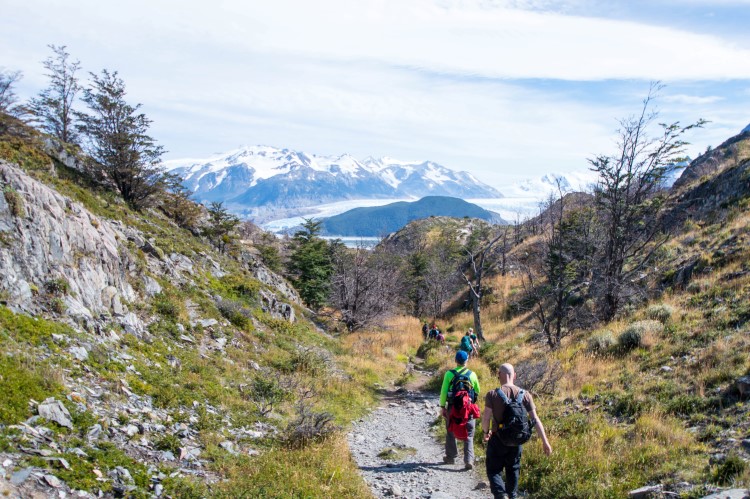
Hiking the W independently costs $157,000 CLP per person ($173 USD – check here for the most up-to-date conversion), plus the cost of food .
Camping and Transport cost breakdown*
- Return bus from Puerto Natales to Torres del Paine National Park: $18000 CLP ($19 USD)
- Adult entrance fee into the park: $44,500 CLP ($55 USD)
- One-way ferry from Pudeto de Paine Grande Ranger Station: $42,600 CLP ($45 USD)
- Grey Campsite: $11,000 CLP (per person) ($11 USD)
- Paine Grande Campsite: $12,000 CLP (per person) ($13 USD)
- Francés Campsite: $38,000 CLP (per person) ($40 USD)**
- El Chileno Campsite: $38,000 CLP (per person) ($40 USD)***
* these figures are all updated for the 2024/2025 season.
**based on two people sharing a tent
***Torres Ranger Station (the free camping closest to the towers) is closed for the foreseeable future.
Food breakdown
- When we hiked the Full Circuit, we paid $68,620 CLP ($95 USD) between four people for all of our food. That’s $17,155 CLP ($20,5 USD) per person. No kidding.
- So for your food budget, expect to spend no more than $10,000 CLP ($12 USD) (read this full outline of exactly what we took with us in terms of food when we walked the Circuit)
If you want to save time, the website Torres Hike can show you the availability of accommodation and allows you to book it directly through them , rather than having to go via the Vertice Patagonia and Las Torres (previously known as Fantastico Sur) websites. All you need to do is plug in your dates and it’ll show you which campgrounds and refugios are available – saving you LOTS of time. You can then book directly with them, rather than having to try and book through the other websites!
How do you make campsite and refugio bookings for Torres del Paine?
The system for making refugio and camping reservations has changed dramatically over the past couple of years and a lot of the information you find online about the subject is out of date.
I also put together this epic, 5,000-word post about securing camping reservations in Torres del Paine that literally walks you through the process. However, I highly recommend just using Torres Hike . Yes, they charge you a small fee, but it honestly saves you so much time.
The reason it’s so challenging to make reservations independently is because there are two different companies who offer campgrounds and dorms in the park and you will have to reserve some campgrounds with one on their website and some with another on their website; trust me, it’s a painful process. Save yourself the stress and hassle of doing this by using Torres Hike instead.
Reservations are now open for the 2023/2024 season. If you’re struggling to find spots for the coming season, you should also read my article about alternative ways to hike the W if you can’t get camping reservations .
You can also check out this ultimate guide to Torres del Paine National Park , covering everything from the best time to visit, to where to stay and what to do beyond the W trek.
If you’re completely baffled by the process and just want someone else to deal with it, you can book with my partner in the region, Chile Nativo , who organise, guided, self-guided and fast-track (three-day) W treks. They give a 5% discount to Worldly Adventurer readers (use “Worldly Adventurer” in the referral discount box when you book!).
What equipment do you need to hike the W without a tour?
To pay as little as possible trekking Torres del Paine solo, it does require that you have the following pieces of equipment:
- A tent: I strongly recommend the lightweight Big Agnes Copper Spur HV UL2 tent ( REI | Backcountry | Amazon ), the North Face Stormbreak 2 (buy it on REI | Amazon ), or, for more room, the North Face Stormbreak 3 (buy it on ( REI ).
- A sleeping bag: I recommend the Nemo Disco 15 for women (buy it on REI ) and for men (buy it on REI ).
- A sleeping pad: Get a cheap foam pad ( REI | Backcountry | Amazon ) or a more comfortable Therm-a-rest Prolite (buy it on REI | Backcountry | Amazon ).
- A headlamp : Useful for midnight toilet visits and the hike up to the towers (buy one on REI | Black Diamond | Backcountry ).
- A cooking stove and gas: The affordable MSR PocketRocket 2 (buy it on REI | Backcountry | Amazon ) is great value for those on more of a budget, and is super lightweight.
- Cooking pots: I recommend the MSR pots set (buy them on Backcountry | Amazon ) as they’re good quality and food will stick less, which will make them easier to clean.
- Plates, a mug, and cutlery : A collapsible bowl is a great space saver (check out Sea to Summit on REI | Backcountry | Amazon ); I recommend a reasonably cheap, plastic mug (buy it on REI | Backcountry | Amazon ) and for cutlery, a multipurpose spork is a good choice (check them out on REI | Backcountry | Amazon ).
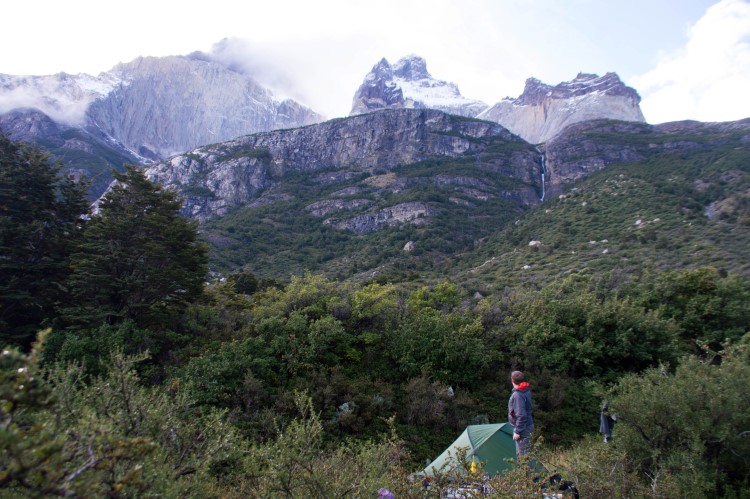
I’ve detailed exactly the items that I packed for the O Circuit in Torres del Paine (and which are still relevant to the W trek) and also what I pack in my rucksack on a trip to Patagonia in this packing checklist . Both have a free packing checklist download, too.
I recommend you take a look if you’re thinking of investing in camping equipment before you head over to Patagonia (something I would strongly advise if you plan on doing any other hikes or wild camping or if you’re looking at exploring the Carretera Austral ).
Planning Your Trip to Patagonia?
Save time, stress & money with a customized travel itinerary planned for you by a Patagonia expert
What previous clients have said:
Steph’s help laying out an itinerary for Chile was huge toward us having a great trip. She listened to our interests and compiled a framework that we could follow to make our plans. She included many practical tips as well as numerous options. She truly saved us many, many hours of research.
If you’re already traveling around Patagonia, what can you do to get your hands on this camping equipment for Torres del Paine?
You have three options:
Buy equipment in Punta Arenas or Puerto Natales
There is a wide range of hiking and camping equipment shops in these two towns. Punta Arenas is a tax-free zone so prices here are cheaper than you will find in Puerto Natales, although Calle Manuel Bulnes in the latter has some gear shops.
I actually found a pair of waterproof trousers for only $15,000 CLP ($18 USD) in one of the shops there, which is a lot cheaper than I thought they would be.
If you’re looking to buy equipment for camping and hiking in Torres del Paine National Park, you should be able to find everything that you need in these shops, but you will pay an elevated price for good-quality gear.
Estimated additional cost: $360,000 CLP+ ($400 USD+) per person
Rent equipment from Puerto Natales
Your second option is to rent all of your camping and cooking equipment from Puerto Natales. Yaghan House (O’Higgins 584; contact them here to reserve; they also have a 12pm daily talk about the park) and Lili Patagonico’s (Arturo Prat 479; you can book online here ) have cheap, good-quality rental gear. Rental Natales (you can book online) has more stock but is very expensive.
Remember to check the equipment thoroughly before committing as it does get a lot of wear and tear on the trail and you want something without holes and with zips that close to keep you warm and dry!
Estimated additional cost: $147,000 CLP ($162 USD) per person (based on two sharing) for five days’ rental
Rent equipment at each campsite in Torres del Paine National Park
Your final option is by far the most expensive. Each of the main camping grounds in Torres del Paine rents out tents, sleeping bags, and sleeping mats – but at a very high cost.
For example, in Grey campground, you can hire a two-man tent for $29,000 CLP ($32 USD), a sleeping bag for $21,000 CLP ($23 USD), and a sleeping mat for $8,000 CLP ($9 USD), bringing up your overnight cost (including the cost of the camping site) to $53,000 CLP ($58 USD) per person per night (based on two sharing).
Bear in mind, this doesn’t include the cost of hiring cooking equipment (which you can’t do at the campsites), so you will also need to pay for meals at each – an additional cost of between $55,000 CLP ($61 USD) and $80,000 CLP ($88 USD).
Estimated additional cost: $232,000 CLP ($256 USD) per person for equipment and $256,000 CLP ($282 USD) per person for full board for five days hiking the W circuit (based on two sharing).
How do you get from Torres del Paine National Park to Puerto Natales ?
It’s easy enough to get to Torres del Paine National Park with public transport.
Four companies travel from Puerto Natales to Torres del Paine each morning and all cost around $22,000 CLP ($25 USD) for a return ticket (which can be used on any of the company’s buses back from the park).
You can buy tickets online for Bus Sur (who have lots of departures); other companies do run this route, however you need to buy tickets from their offices, which are inside the Terminal Rodoviario (Av. España 1455) in Puerto Natales.
If there are a few of you, consider negotiating a group price like we did, which got us a few thousand pesos off per ticket.
It’s advisable to book your bus ticket at least a week in advance when visiting the park in high season (December through February).
Timetables for buses from Puerto Natales to Torres del Paine (east to south: Laguna Amarga, Pudeto and Administración)*
Conventionally, buses have departed from Puerto Natales and entered the park via the northeastern entrance at Laguna Amarga (for the minibus to the eastern starting point for the W), before continuing to Pudeto (for the catamaran to the western starting point for the W) and finally to Administración (not a destination along the W trek).
These now continue along to Hotel Lago Grey and stop at Camping Pehoé en route, too.
These bus timetables are below and can be booked online in advance via Bus Sur’s website:
Pre-pandemic, the following companies also offered services. However, their websites are no longer active and I can’t find them on any local booking sites.
That doesn’t mean they don’t have buses, however; if you can’t get a reservation with Bus Sur then it’s still worth going to the bus terminal in Puerto Natales as some will likely still be in operation and with similar departure times:
- Transport Maria José (tel. 61/2410 951)
- Buses Gómez (tel. 61/2415700)
- JB Buses Patagonia (tel. 61/2410 242)
- Buses Juan Ojeda (tel. 9/8943 7808)
*Service available November through April
Timetables for buses from Torres del Paine to Puerto Natales (Administración, Pudeto, Laguna Amarga)*
The following timetables are when buses can return you to Puerto Natales from the four different stops in the park. They can also be booked online and in advance via Bus Sur’s website.
Note that you have to return with the same bus company you entered the park with – you won’t be allowed on a different company’s buses. You don’t have to book a particular bus time; you will be able to turn up and get onto whichever bus you choose.
As above, there should be other companies offering buses to and from Puerto Natales into the park; visit the Terminal Rodovario in Puerto Natales to find out if you can’t make a reservation with Bus Sur.
Where do you buy your Torres del Paine entrance ticket?
The cost of entering the park varies according to how long you plan on staying. For up to three days in the park, it costs $31,200 CLP ($34 USD) for adults and $16,000 CLP ($17 USD) for children aged 12 to 17. For over three days in the park, the cost is $44,500 CLP ($48 USD) for both adults and children.
It’s no longer possible to buy your ticket at the Laguna Amarga entrance to the national park (the first stop on the bus if entering via that entrance) or at the Administración entrance (if entering via that entrance).
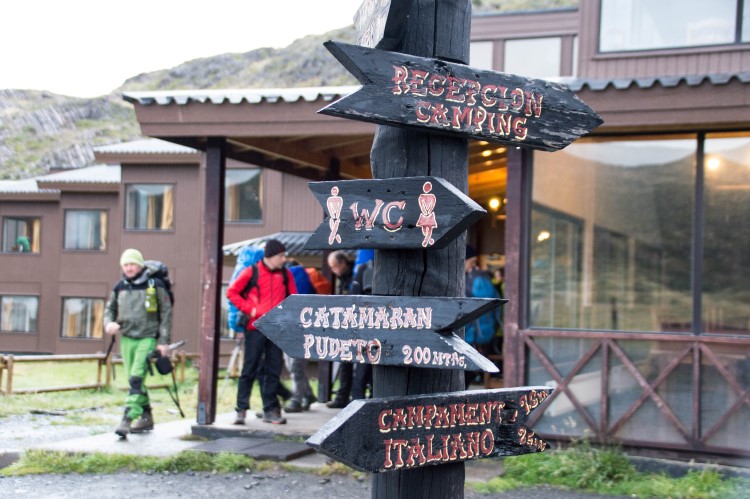
You must buy it in advance online here . You must download the QR code to your phone before you enter the park (as you won’t have signal when you get there!) and bring your passport to show that you’re not a Chilean resident.
Torres del Paine W trek itineraries
Hiking in Torres del Paine National Park is significantly cheaper if you go self-guided.
There is also absolutely no chance that you’ll get lost. Believe me, the W trek is now so busy that (unfortunately) you see people all the time.
If you want to trek Torres del Paine solo, you can either hike from west to east (my preference, as I’ll go into below) or east to west.
When you enter the park and pay your fee, you will be provided with a Torres del Paine W trek map to be used when you’re walking.
Unfortunately, the map that you get from CONAF doesn’t include distances. I would strongly recommend you download Maps.me, a free app that has all the trails marked and you can use it to work out distances if required.
Itinerary one: W trek in five days with sunrise at Mirador Las Torres (west to east route)
Why hike this route:
- This trail builds up to the most exciting part of the trek, the Mirador Las Torres viewpoint on the final day.
- It also starts with a short first day, giving you time to get into your stride.
Want to know how to book the campsites mentioned in this itinerary? Head over to this comprehensive article about booking Torres del Paine camping or hostel accommodation .
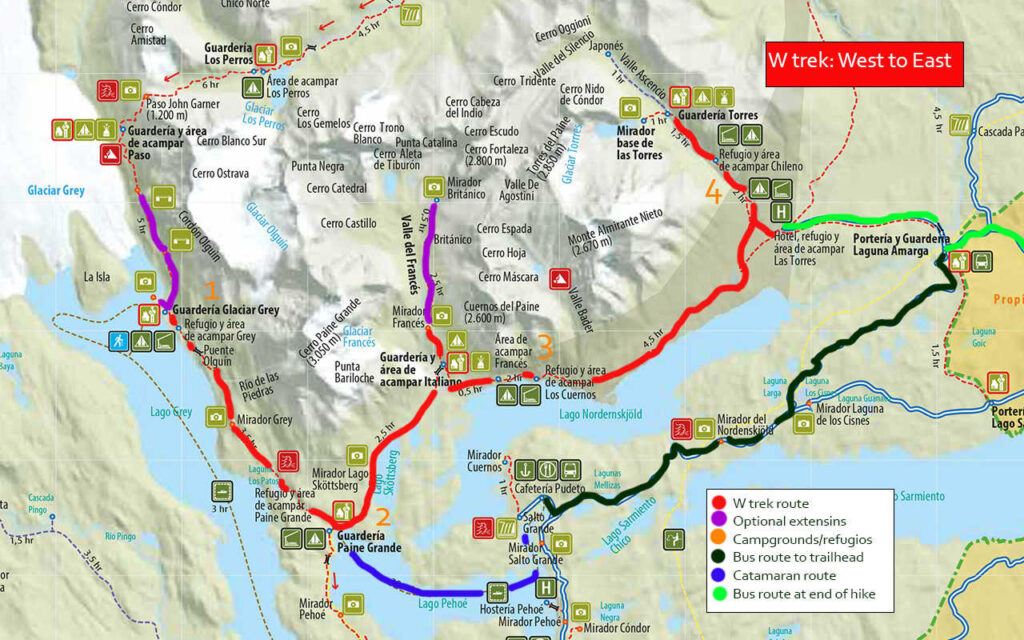
Day One: Puerto Natales to Grey
- Distance: 11 kilometers (6.8 miles)
- Duration: 3-4 hours hiking
6:50am Take a bus from Puerto Natales to the Pudeto (the catamaran ferry stop). You will stop at the park entrance when you first get into Torres del Paine to show your entrance ticket.
You must have bought this in advance online here and downloaded the QR code to your phone (there isn’t internet cell service at Laguna Amarga!).
9:50am Arrive at Pudeto. Queue up for the catamaran ferry across the lake.
10:30am Take the ferry across to Paine Grande*. Tickets are available here ($26,000 ($30 USD) single), meaning you only need to arrive 15 minutes ahead of the ferry departure time.
Ferry schedules do sometimes change; you can check up-to-date ones here .
11:40am Arrive at Paine Grande and trek to Grey. The trail starts to go uphill but soon levels off and has great views of Lago Grey to keep your spirits up!
16:00pm The hike from Paine Grande takes between three and four hours so expect to arrive late afternoon at Grey to pitch your tent, meet some other hikers, and cook dinner.
Day Two: Grey to Paine Grande
- Distance: 18 kilometers (11 miles)
- Duration: 6-7 hours hiking
8:00am Wake up and have breakfast.
9:00am Leave your stuff at the campsite and return a few hours later to pack everything up. From the campsite, an additional one kilometre north through the forest brings you go two viewpoints lying over a kilometre from the glacier’s snout. From here, look out for enormous chunks of ice in the water.
Continue a further 2.5 kilometres (around a one-hour hike) along the path along the edge of the glacier to reach a series of two rope bridges hanging over ravines.
From here you get the best views of the glacier and, if you’re lucky and it’s a clear day, the Southern Patagonian Ice Field beyond.
Return to Grey along the same path and back to Paine Grande.
16:00pm You’ll arrive at Paine Grande at around 4pm, which is where you’ll spend the night. The facilities are great here, with a covered dining area for campers.
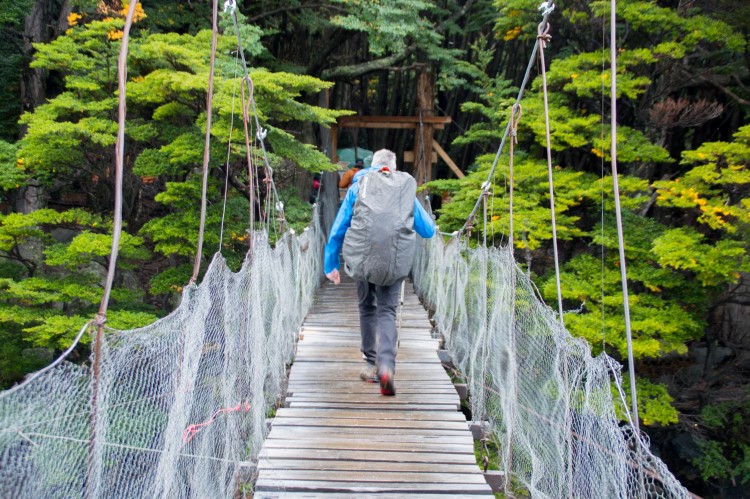
Day Three: Paine Grande to Francés
- Distance: 11.5 kilometers (6.8 miles) plus 9 kilometers (5.6 miles) for the extension to Mirador Británico)
- Duration: 4 hours hiking (7.5 hours with extension to Mirador Británico)
8:00am Get up, have breakfast and pack up your tent.
9:00am Today begins with a flattish trek around Lake Nordernskjold to Guardería Italiano. You can leave your bags here with the ranger before hiking up into the Francés Valley.
Note that there’s a new trail that begins about one km (15 mins) after you leave Paine Grande. It’s a little longer – 9 km (5.6 miles) rather than 7 km (4.3 miles) – and so takes around 30 minutes longer, but it has fewer hikers on it and is really pretty.
11:00am The hike up the Francés Valley may be long or painfully short – all depending on the weather. Both times I’ve walked Torres del Paine W hike I’ve experienced dreadful weather in the Francés Valley.
This part of the hike marks the central section of the W and it’s all uphill. After an hour’s steep gradient up a rocky, slippery trail to Mirador Francés, look for Glaciar Francés as it clings to the mountainside in the west.
If you’re feeling energetic, and the weather’s playing fair, you can continue climbing to Mirador Británico (an additional 3.5 km (2 miles) each way; around three hours’ return), where you’ll view a ring of toothy granite peaks, including the park’s second most famous landmark, the three-horned Cuernos del Paine.
It’s one of the park’s most stunning viewpoints—when the sky is clear. You may even see an endangered Southern Andean huemul (a type of deer) around here.
Luckily, the hike back is downhill to return to Campamento Italiano, where you pick up your rucksack and hike the 30 minutes to reach Francés.
13:00pm-16:00pm Arrive at Francés*, pitch up and enjoy the views across the lake.
*If there is no availability at Francés when you go to make your refugio or campsite reservations , you can instead book to stay at Los Cuernos, which is a further 3.5 kilometers (one hour) from Francés.
Day Four: Francés to El Chileno*
- Distance: 17 kilometers (10.5 miles)
- Duration: 4-5 hours hiking
9:00am Leave the campsite and begin the trek to El Chileno, situated about two hours from the bottom of the towers.
This trek meanders alongside the lake, gaining and losing altitude as it goes, until you reach the start of the valley where it becomes all uphill. The views are incredible but if it’s sunny, it will be hot!
16:00pm Arrive at El Chileno* and pitch your tent. Get everything organised for the morning as you’ll be leaving early. Check with the staff what time sunrise will be the next morning.
*For the 2023-2024 season, and for the foreseeable future, Torres Ranger Station is not open to the public. It’s no longer as easy to get to the towers for dawn as the distance is now around four kilometres, rather than one kilometre; however, it is still possible to do it.
If you can’t get a pitch at Chileno, it is possible to hike from Torres Central/Norte ($25 USD camping pitch per person). Although you’re not officially supposed to hike from here up to the towers, you can: leave four hours ahead of sunrise. It’s an additional one-hour 45 minutes if starting from Torres Central/Norte to reach the towers.
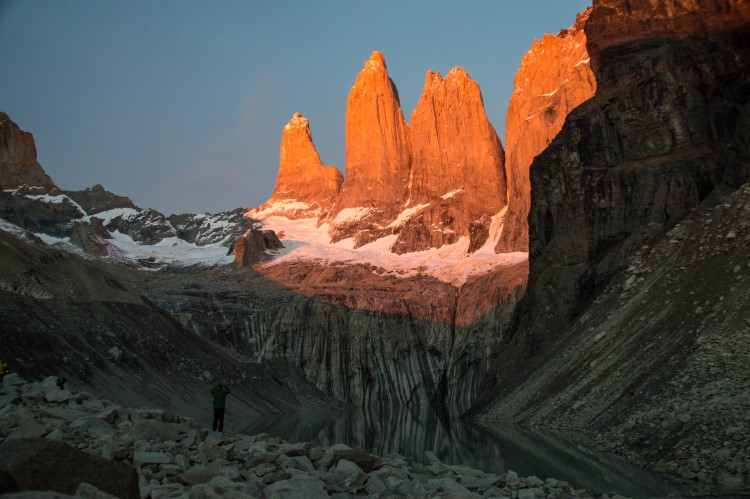
Day Five: El Chileno* to Laguna Amarga and Puerto Natales
- Distance: 13 kilometers (8 miles) plus 8 kilometers (5 miles) for the hike from the Centro de Bienvenida to Laguna Amarga)
- Duration: 6 hours hiking (add an extra 1.5-2 hours for the hike to Laguna Amarga)
4:30am Wake up and take a small bag (including warm clothes and a snack) to see the torres at dawn. Don’t forget your torch as the route is over rocks and can be treacherous.
4:45am Start hiking up to the torres . For us at the very start of March, dawn was at about 7:15am.
8:00am Leave the torres and return to the campsite. Pack up, have breakfast start the long walk down.
12.30pm When you get to Las Torres Hotel car park, there is a shop selling ice creams. To get the shuttle minibus to take you to Laguna Amarga, you need to hike one kilometre down the road towards Torres Central/Norte to reach the Centro de Bienvenida /Welcome Centre.
Shuttles ($4,000 CLP ($6 USD) – you must pay in cash at the shuttle) leave throughout the day to take you to Laguna Amarga. Departures leave the Welcome Centre at 8am, 2pm, 4pm and 7pm daily , and take about 30 mins.
If you can face the walk, it’s about another one and a half hours to the Laguna Amarga Ranger Station where buses are waiting to pick you up.
Hiking there, you can get good views of the towers as they rise out of the Cordillera Paine if the weather is clear.
14:30pm Take the bus from Laguna Amarga back to Puerto Natales.
17:00pm Arrive in Puerto Natales bus station and go and enjoy a pint at Cerveza Baguales on the Plaza de Armas to celebrate!
If time allows, consider spending a night in Puerto Natales to explore all the town has to offer before your onward journey. Our guide to the best hotels in Puerto Natales caters for all budgets, styles and preferences.
*If you can’t get a pitch at Chileno, it is possible to hike from Torres Central/Norte ($21 USD camping pitch per person). Although you’re not officially supposed to hike from here up to the towers, you can: leave four hours ahead of sunrise. It’s an additional one-hour 45 minutes if starting from Torres Central/Norte to reach the towers.
Make sure you bring a headtorch for climbing in the dark (it will get lighter as you reach the more difficult stretch of hiking just below the towers), plus warm clothing (even including a sleeping bag) to use at the top and keep you cozy as you enjoy the sunrise.
Itinerary two: Torres del Paine W trek in four days with sunrise at Mirador Las Torres (west to east route)
Why hike this route?
- It’s a good option if you don’t have much time
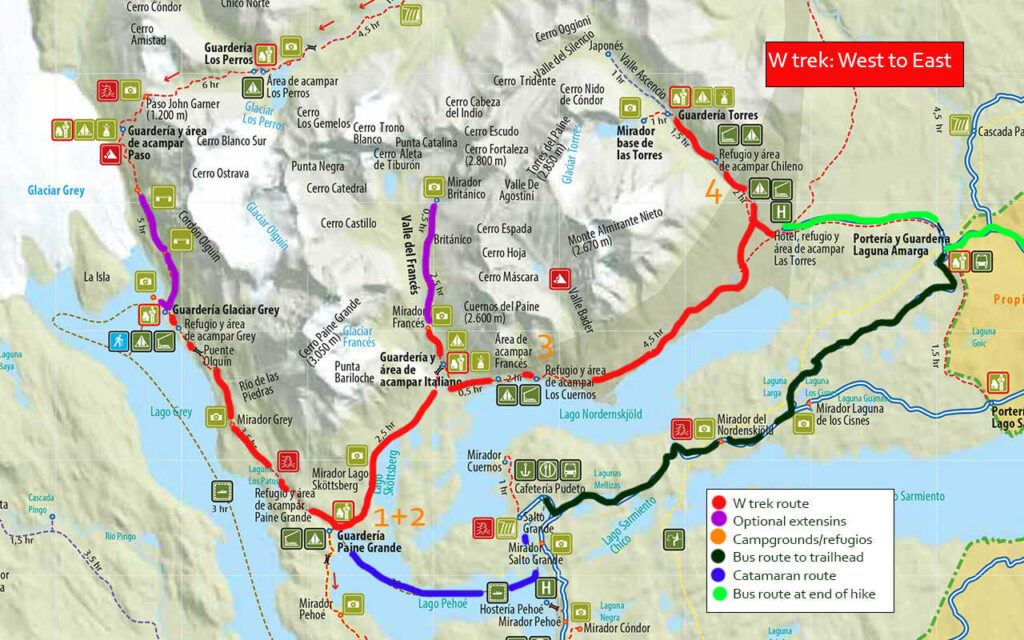
Day Zero – Puerto Natales to Paine Grande
- Distance: nil
- Duration: nil
2.30pm Catch the Bus Sur bus from Puerto Natales.
You will stop at the park entrance at Laguna Amarga when you first get into Torres del Paine to pay your entrance fee.
You must have paid for your ticket in advance online here AND downloaded the QR code; you will not find cell service or WIFI at the entrance.
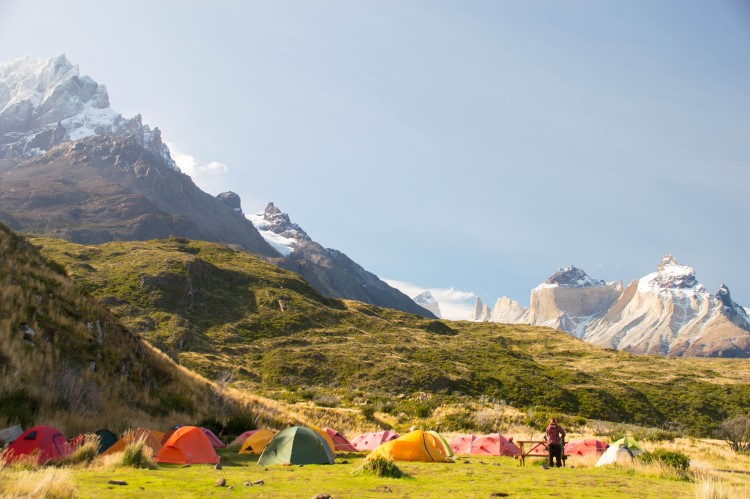
5.15pm Arrive at Pudeto and take the ferry across to Paine Grande at 6pm. Tickets are available here ($26,000 ($30 USD) single, cash only).
Tickets can be purchased ahead of time online, meaning you only need to get to the ferry port 15 minutes prior to departure. Ferry schedules and prices do sometimes change; you can check up-to-date ones here and the 8.30am ferry only runs November through the end of March.
6.30pm Pitch up at Paine Grande, have some dinner and then have an early night in preparation for a long day’s hiking tomorrow.
Day One – Paine Grande to Paine Grande
- Distance: 22 kilometers (14 miles) plus 7 kilometers (4.3 miles) if you hike to the last viewpoint)
- Duration: 7-9 hours hiking
7:00am Get up, have breakfast, and pack up your tent.
08:00am Take the trail towards Grey; it starts uphill but soon levels off and has great views of Lago Grey to keep your spirits up!
If you’re fit, you can hike an additional one kilometre north through the forest brings you go two viewpoints lying over a kilometre from the glacier’s snout. From here, look out for enormous chunks of ice in the water.
Turn back and return the way you came, past Grey and then back to Paine Grande.
17:00pm Arrive late afternoon back at Paine Grande to meet some other hikers and cook dinner.
Day Two – Paine Grande to Frances
9:00am Hike to the ranger station, Guardaria Italiano (around two hours), where you leave your rucksack with the ranger. You’ll pick it up on your way back down from the Francés Valley.
The hike up the Francés Valley may be long or painfully short – all depending on the weather. Both times I’ve walked Torres del Paine W hike I’ve experienced dreadful weather in the Francés Valley.
If you’re feeling energetic, and the weather’s playing fair, you can continue climbing to Mirador Británico (an additional 3.5 km each way; around three hours’ return), where you’ll view a ring of toothy granite peaks, including the park’s second most famous landmark, the three-horned Cuernos del Paine.
Luckily, the hike back is downhill to return to Italiano, where you pick up your rucksack and hike the 30 minutes to reach Francés.
*If there is no availability at Francés when you go to make your refugio or campsite reservations , you can instead book to stay at Los Cuernos, which is a further 3.5 kilometres (one hour) from Francés.
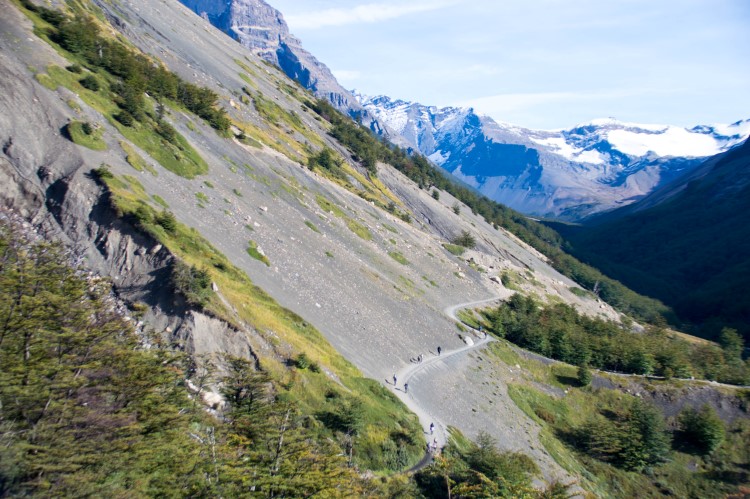
Day Three: Francés to El Chileno*
9:00am Leave the campsite and begin the trek to El Chileno, situated about two hours from the bottom of the towers. This trek meanders alongside the lake, gaining and losing altitude as it goes, until you reach the start of the valley where it becomes all uphill.
The views are incredible but if it’s sunny, it will be hot!
*For the 2023-2024 season and for the foreseeable future, Campamento Torres, the campground just below the towers, is not open to the public. It’s no longer as easy to get to the towers for dawn as the distance is now around four kilometres, rather than one kilometre; however, it is still possible to do it.
Day Four: El Chileno* to Laguna Amarga and Puerto Natales
Shuttles ($4,000 CLP ($6 USD) – you must pay with cash in the shuttle) leave throughout the day to take you to Laguna Amarga. Departures are at 8am, 2pm, 4pm, 7pm and takes about 30 minutes.

*If you can’t get a pitch at El Chileno, it is possible to hike from Torres Central/Norte ($25 USD camping pitch per person). Although you’re not officially supposed to hike from here up to the towers, you can: leave four hours ahead of sunrise.
Make sure you bring a headtorch for climbing in the dark (it will get lighter as you reach the more difficult stretch of hiking just below the towers), plus warm clothing (even including a sleeping bag) to use at the top and keep you cosy as you enjoy the sunrise.
Itinerary three: Torres del Paine W hike in five days (east to west route)
Why hike this route:
- Not only do you get to complete the W, it gives you time for a bonus extra hike to the Los Cuernos or Salto Grande viewpoints.
Want to know how to book the campsites mentioned in this itinerary? Head over to this comprehensive article about booking Torres del Paine camping or hostel accommodation .
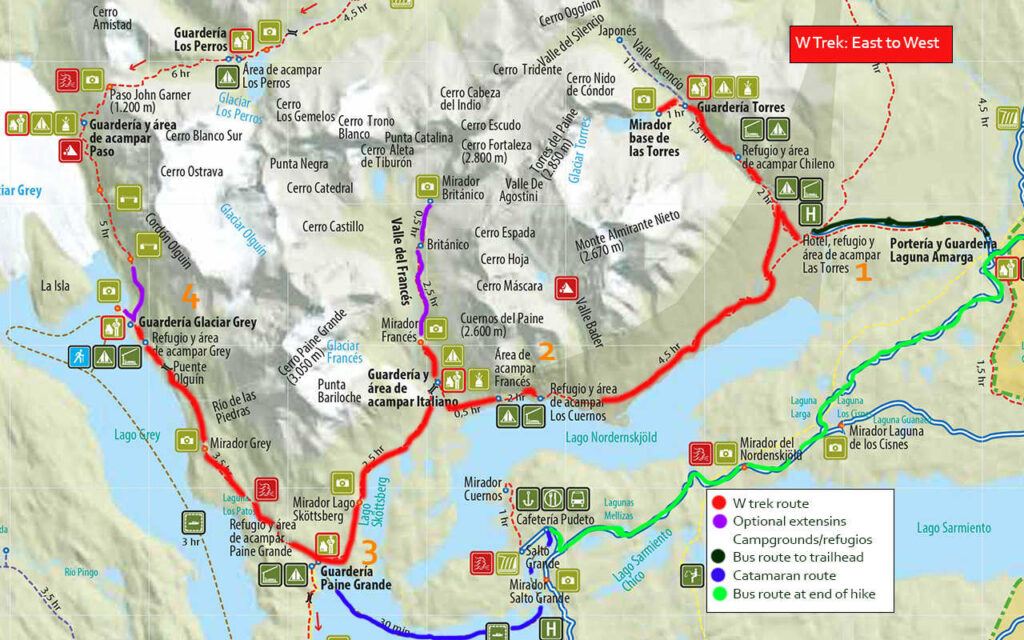
Day One: Puerto Natales to Mirador Las Torres & Torres Central/Norte
- Distance: 18.4 kilometers (11.4 miles)
- Duration: 6-7 hours hiking
6:45am Take a bus from Puerto Natales to Laguna Amarga. You can book tickets online with Bus Sur or go to the bus station in Puerto Natales the day before you start hiking and book with them or one of the other companies there.
8:45am Arrive at Laguna Amarga. Show your entrance ticket at the ranger’s station.
9:00am To get to the start of the W, you need to take a shuttle bus ($4,000 CLP ($6 USD) – you must pay in cash at the shuttle) to the Centro de Bienvenida (Welcome Centre).
Departures theoretically leave from Laguna Amarga at 9am, 3pm, 5pm and 8pm daily , and take about 30 mins. However, Las Torres (who run the shuttle service) have assured me that the shuttle bus awaits the arrival of the bus from Puerto Natales and will take all passengers that are waiting to board – sending for a second shuttle if there are more passengers than seats.
9.30am You’ll be staying overnight at the Torres Central/Norte campground, so check in and leave your big bags and take warm layers, food, and plenty of water for the hike up to the towers.
Start hiking up to the torres . It’s all uphill and it can be quite steep at points, but it’s worth the effort! All in all, you gain around 800m (2,620 feet).
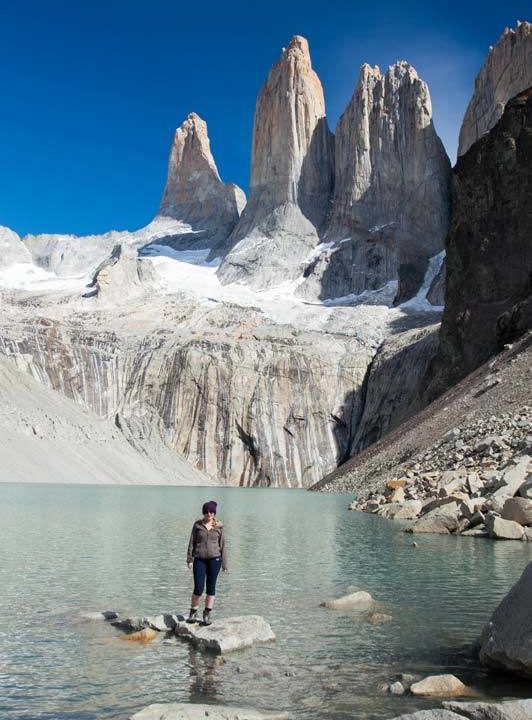
Take your time, drink plenty of water, and relax when you get to the top.
13:30pm Arrive at Mirador Las Torres and enjoy the views.
15.00pm Start hiking back to the campsite; you’re trekking back the way you came.
17.00pm Pitch your tent, have dinner, and relax!
Day Two: Torres Central/Norte to Francés
- Distance: 14.5 kilometers (9 miles)
- Duration: 5.5 hours hiking
9:00am Get up, have breakfast and pack up your tent.
10:00am You leave Torres Central heading west and reach Lago Nordernskjold. The trail meanders alongside the lake, gaining and losing altitude as it goes. The views are incredible but if it’s sunny, it will be hot!
15:30pm Reach Francés campground, where you’ll stay tonight. Pitch up and enjoy views across the lake. Bear in mind that check-in at Francés doesn’t start until 2.30pm and hot showers aren’t available until 5pm, so take your time on the hike.
Day Three: Francés to Mirador Británico & Paine Grande
- Distance: 14 kilometers (8.6 miles) from Francés to Mirador Británico and 7 kilometers (4.3 miles) from Guardería Italiano to Paine Grande
- Duration: 5.5 hours hiking from Francés to Mirador Británico and 2.5 hours from Guardería Italiano to Paine Grande
9:00am If the weather is good, today is going to be a long day as you climb up into the Francés Valley. Both times I’ve walked Torres del Paine W hike I’ve experienced dreadful weather in the Francés Valley.
From Francés, head west along the path beside the lake to reach Guardería Italiano, a rangers’ station and former (now defunct) campground. Here, you can drop your big rucksacks; just take warm clothing and food for the hike up to the Mirador Británico* (British Viewpoint). This part of the hike marks the central section of the W and it’s all uphill. After an hour’s steep gradient up a rocky, slippery trail to Mirador Francés, look for Glaciar Francés as it clings to the mountainside in the west.
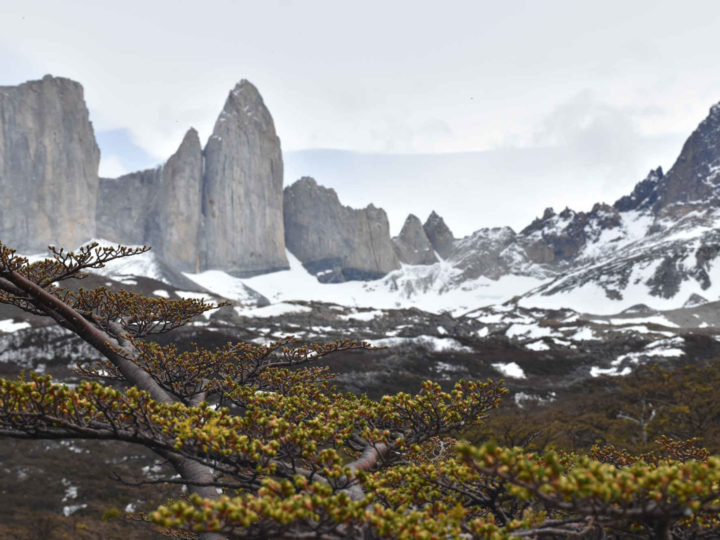
Luckily, the hike back is downhill to return to Guardería Italiano. Pick up your bags and take the new trail that begins just after the rangers’ station; take the lefthand fork that follows closer along the lake. It’s a little longer – 9 kilometers (5.6 miles) rather than 7 kilometers (4.3 miles) – and so takes around 30 minutes longer, but it has fewer hikers on it and is really pretty.
18:30pm Arrive at Paine Grande, pitch your tent and enjoy a hot shower!
*You’re only allowed to start hiking up to the viewpoint until midday, so don’t delay getting to the rangers’ station – although this rule isn’t always enforced!
Day Four: Paine Grande to Grey & Puerto Natales
- Distance: 11 kilometers (6.8 miles) plus six kilometers (3.7 miles) to reach rope bridges
- Duration: 4 hours hiking plus 1.5 hours to reach rope bridges
10:00am Take the trail heading north to Grey. It starts by going uphill but soon levels off and has great views of Lago Grey to keep your spirits up! It takes between three and four hours.
14:00pm Arrive at Grey, where you can leave your big bags. From the campsite, an additional one kilometre north through the forest brings you to two viewpoints lying over a kilometre from the glacier’s snout. From here, look out for enormous chunks of ice in the water.
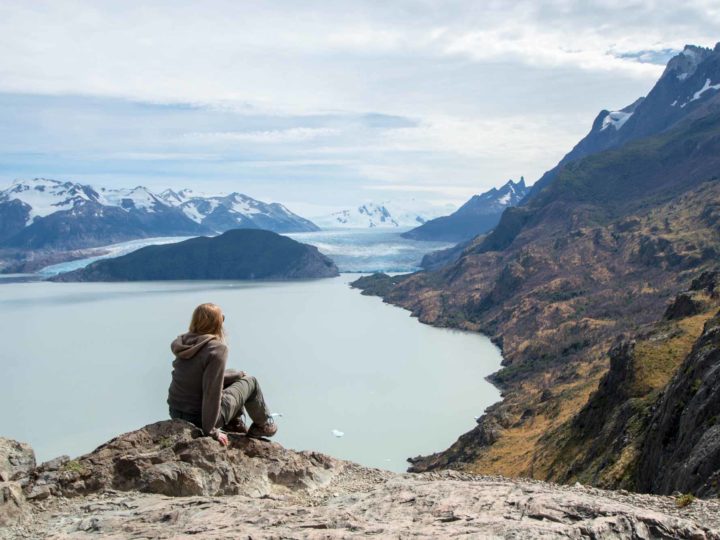
From here you get the best views of the glacier and, if you’re lucky and it’s a clear day, the Southern Patagonian Ice Field beyond. Return back to Grey.
16:00pm Arrive at Grey, pitch up and relax – you’ve almost finished the hike!
Day Five: Grey to Paine Grande and Puerto Natales
- Distance: 11 kilometers (6.8 miles) plus 2.3 kilometers (1.4 miles) to the Cuernos Viewpoint
- Duration: 4 hours hiking
7:00am Get up, pack up your tent, and have breakfast. Return to Paine Grande along the same path.
10:30am Join the queue for the ferry to Pudeto.
11:00am Take the ferry to Pudeto. Tickets are available online here ($26,000 ($30 USD) single, cash only).
11:30am Arrive at Pudeto. From here, you can either have lunch in the tiny cafeteria at the ferry dock or you can hike from Pudeto to the Cuernos Viewpoint, a 2.3-kilometer (1.4-mile) one-way hike from the ferry dock; it should take you around an hour each way and grants you incredible views west and east along the Paine Massif range.
A shorter option is the 600-meter (0.3-mile) trail to the Salto Grande Waterfall, which has stunning views of Los Cuernos behind it.,
2:30pm Take the bus from Pudeto back to Puerto Natales. You should arrive around 5.05pm.
Itinerary four: W trek in five days with sunrise at Mirador Las Torres (east to west route)
- You get to see the sunrise at Mirador Las Torres and hiking to it on your first day means your legs won’t be as tired.
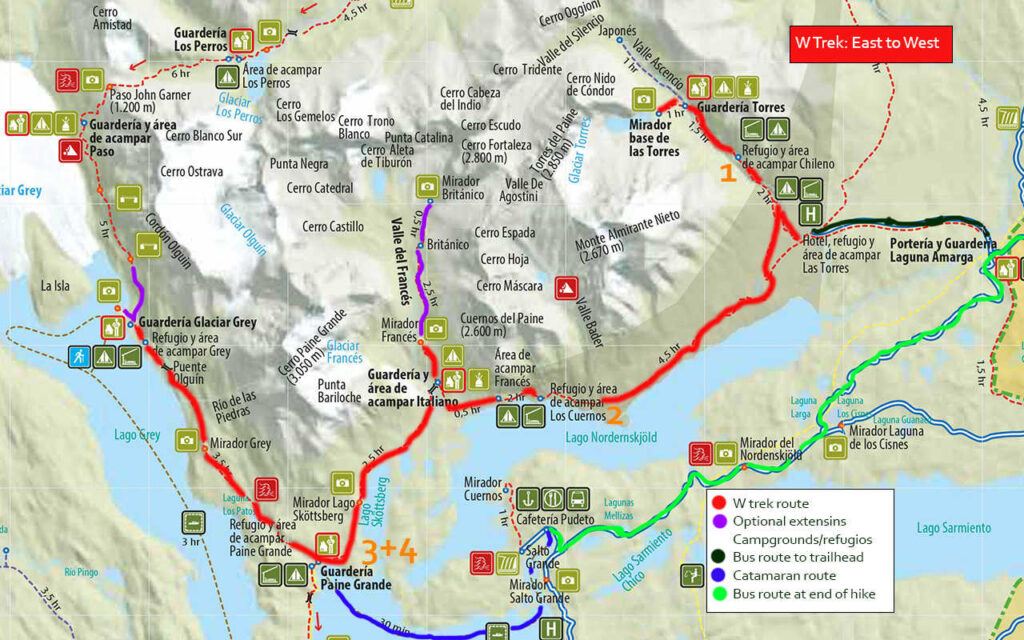
Day Zero: Puerto Natales to El Chileno
- Distance: 5 kilometers (3miles)
- Duration: 2 hours hiking
12:00pm Take a bus from Puerto Natales to Laguna Amarga.
2.00pm Arrive at Laguna Amarga. Show your entrance ticket at the ranger’s station.
2.30pm To get to the start of the W, you need to take the shuttle bus ($4,000 CLP ($6 USD) – you must pay in cash at the shuttle) to the Centro de Bienvenida (Welcome Centre).
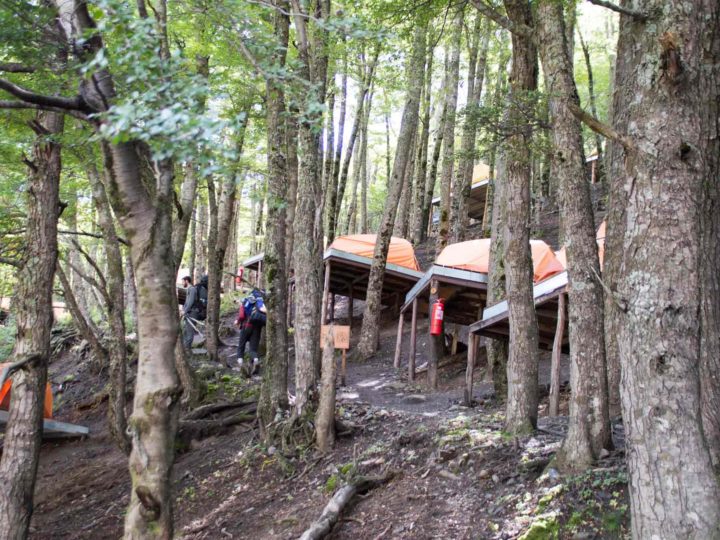
3pm Start hiking up to El Chileno, the closest campground to Mirador Las Torres, the famed viewpoint of the towers. This is the smallest campground, so sells out fast.
If you can’t get a spot here, you’ll need to camp at Torres Norte/Central and hike four hours tomorrow to reach the viewpoint.
5pm Arrive at El Chileno. Set up your tent, have dinner and relax.
Day One: El Chileno to Mirador Las Torres and then Los Cuernos
- Distance: 19.4 kilometers (12 miles)
- Duration: 6.5 hours hiking
4:30am Wake up and take a small bag (including warm clothes, a sleeping bag, and a snack) to see the torres at dawn. Don’t forget your torch as the route is over rocks and can be treacherous.
8:00am Leave the mirador and return to the campsite. Pack up, have breakfast start the walk down. When the trail splits, you’ll need to take the righthand path that goes alongside Lago Nordenskjöld.
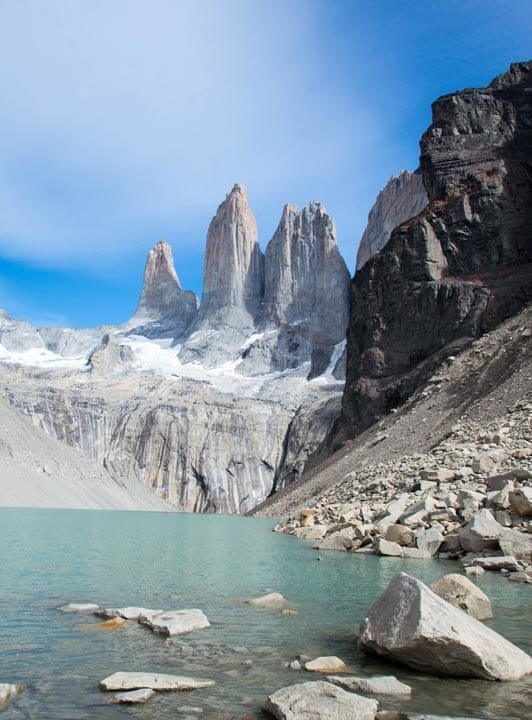
This trek meanders alongside the lake, gaining and losing altitude as it goes. The views are incredible but if it’s sunny, it will be hot!
3:00pm Arrive at Los Cuernos*, pitch up and relax.
*If there is no availability at Los Cuernos, when you go to make your refugio or campsite reservations , you can instead book to stay at Francés, which is a further 3.5 kilometers (one hour) beyond Los Cuernos.
Day Two: Los Cuernos to Paine Grande
- Distance: 17.5 kilometers (10.8 miles) from Los Cuernos to Mirador Británico and 7 kilometers (4.3 miles) from Guardería Italiano to Paine Grande
- Duration: 6.5 hours hiking from Francés to Mirador Británico and 2.5 hours from Guardería Italiano to Paine Grande
7:00am Get up, have breakfast and pack up your tent.
8:00am Today begins with the path alongside Lake Nordernskjold to Guardería Italiano. You can leave your bags here with the ranger before hiking up into the Francés Valley to Mirador Británico*.
10:30am The hike up the Francés Valley may be long or painfully short – all depending on the weather. Both times I’ve walked Torres del Paine W hike I’ve experienced dreadful weather in the Francés Valley.
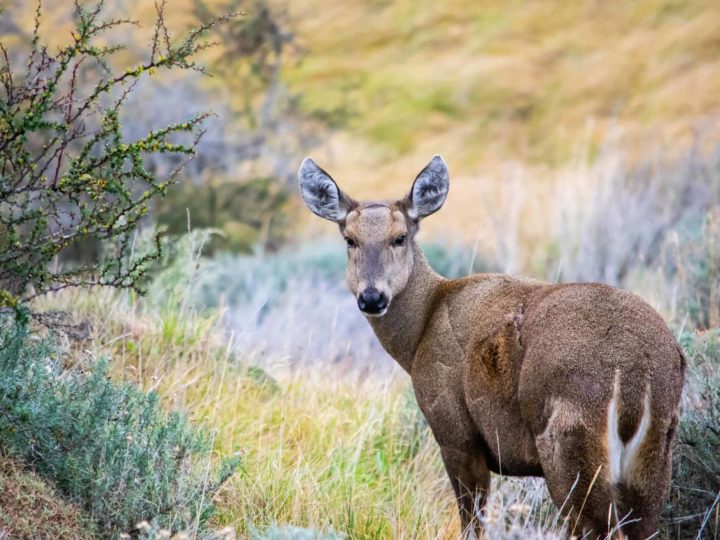
Luckily, the hike back is downhill to return to Campamento Italiano. From there, pick up your rucksack and hike the two remaining hours to reach Paine Grande.
Note that there’s a new trail that begins just after Campamento Italiano; take the lefthand fork that follows closer along the lake. It’s a little longer – 9 km (5.6 miles) rather than 7 km (4.3 miles) – and so takes around 30 minutes longer, but it has fewer hikers on it and is really pretty.
17:00pm-18:00pm Arrive at Paine Grande, pitch up and enjoy the views across the lake.
Day Three: Paine Grande to Grey and back to Paine Grande
9:00am Hike from Paine Grande to Grey; you can leave everything in your tent, except the items you need for today. The trail starts to go uphill but soon levels off and has great views of Lago Grey to keep your spirits up!
13:00pm Arrive at Grey. From the campsite, an additional one kilometre north through the forest brings you to two viewpoints lying over a kilometre from the glacier’s snout. From here, look out for enormous chunks of ice in the water.
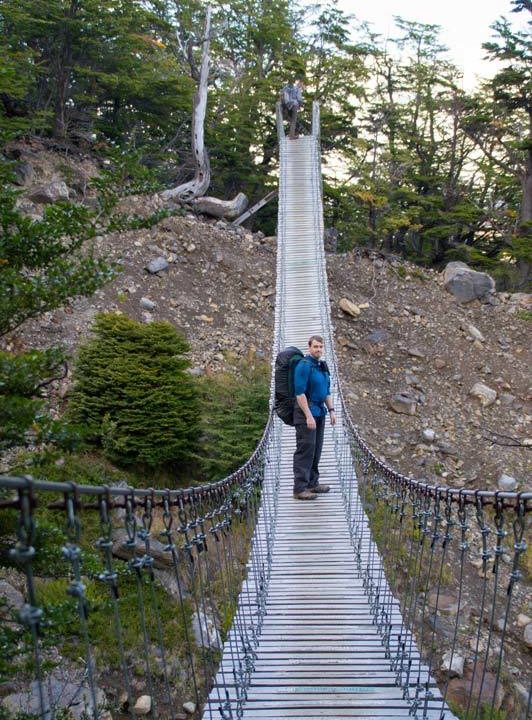
15:00pm Return to Grey along the same path and back to Paine Grande.
19:00pm Arrive at the campground, relax, have dinner and enjoy the feeling of finishing the trek!
Day Four: Paine Grande to Puerto Natales
- Distance: N/A
- Duration: N/A
9.00am Join the queue for the ferry to Pudeto.
9:30am Take the ferry to Pudeto. Tickets are available here ($26,000 ($30 USD) single, cash only).
10:00am Arrive at Pudeto.
10.30am Take the bus from Pudeto to Puerto Natales and celebrate your successful completion of the W!
Top tips for hiking the Torres del Paine W Trek self-guided
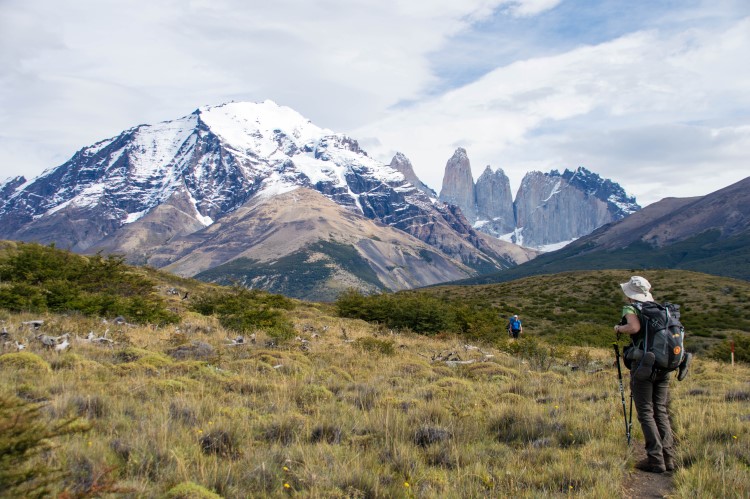
Having now been hiking in Torres del Paine National Park twice, I’ve learned a few important tips that have kept me happy, sane and comfortable en route :
Top equipment tips
- Camping in Torres del Paine at Francés, Los Cuernos, and El Chileno is on wooden platforms. If you plan to stay at any of these campsites, you will need extra cord or string to help you attach your tent without using pegs.
- Bring a range of warm and wet weather clothing. Check out my packing list for hiking the Circuit in Torres del Paine for the full guide to the clothing that I packed for the trip (and which is also a good guide to what to pack for the W). It also includes a free, downloadable checklist.
- Bring a book or some cards for the evenings as you tend to finish hiking quite early and if it’s cold and wet, you’ll want to retire to the shelters with something to do.
- Having a lightweight tent really does make a difference camping on this trek. Have a look at my review of the Big Agnes HVUL2 , the really lightweight backpacking tent that we used for the O Circuit.
- If you’re carrying all of your own equipment, a 60-litre rucksack should be big enough.
- Pack all of your clothes into dry bags (better than a bin bag which can easily rip). The weather changes rapidly and on days when it’s pissing it down, you’ll welcome the fact that your sleeping bag and clothes are dry. I recommend the Sea to Summit dry bags (buy them on REI | Amazon ).
- Bring a rucksack cover. I’ve heard mixed advice on this one, but a rucksack cover kept our bags dry (and so lighter) when we were hiking in Torres del Paine National Park and no, they didn’t blow away in the wind. If your rucksack doesn’t come with its own, you can find them in various sizes on | Osprey | Amazon (make sure it’s the correct size for your bag – otherwise it will blow away!).
Top food tips
- There is a much wider (and cheaper) selection of food in the supermarkets in Punta Arenas than in the one Unimarc supermarket in Puerto Natales. I recommend doing your food shop there before you take the bus to Puerto Natales. We left the stuff we didn’t need in our hostel in Punta Arenas.
- You can also buy trekking food and bring it with you , but it’s heavier and far more expensive than organising your food when you get to Puerto Natales.
- Pack everything into zip-lock plastic bags and bin all the original packaging that you can to save on carrying any extra weight. Also, don’t bring the full pack of rice if you’re only going to eat half of it – every bit of weight counts!
- You can buy basic staples (pasta, biscuits, tomato puree etc.) from the shops at Paine Grande, Grey, Francés and El Chileno to stock up on supplies. It’s pretty expensive, but totally worth it. They also all stock beer – an additional expense that I didn’t include in the costings for the W trek!
- You don’t need to bring water with you as it’s available from all the glacier meltwater streams that you’ll run into along the W and is drinkable from the taps at each of the campsites. If you’re nervous about drinking the water, you can also bring a Steripen (read my review of the Steripen Adventurer or buy one from Amazon or buy a newer Steripen UV Ultra from REI ) to zap anything that might be nasty or a Grayl ( REI | Backcountry | Amazon ) – find out why I recommend these water filters for South American travel .
- My dad is a pro at packing food for multi-day treks. Read what food we took with us for the O Circuit (and which you can use as a guide for the W too).
- You will need Chilean pesos on you for the park as nowhere accepts cards. You’ll need $25,000 CLP ($35 USD) for the catamaran ferry and then extras for additional food, beer, and anything else you want to buy.
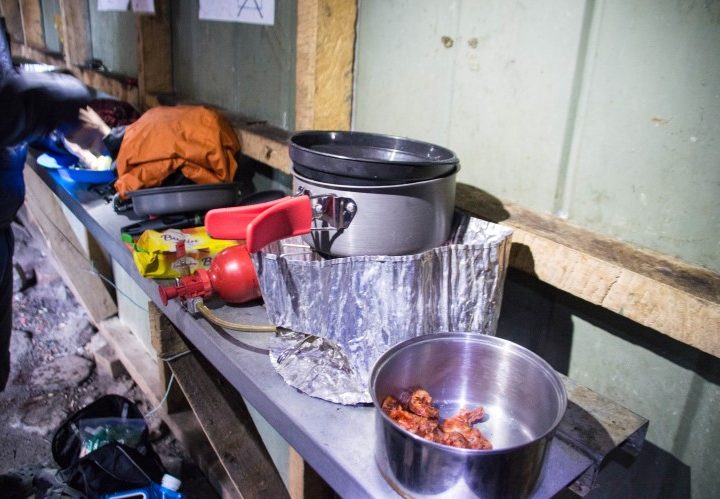

Camping in Torres del Paine
The following summarises some of the main points about booking campsites and refugios in Torres del Paine for the W trek, but you can get a full overview of how to book campsites in Torres del Paine with this article updated for the 2023/2024 season.
Reservations with Las Torres and Vertice Patagonia
You will need to book your campsites in Torres del Paine in advance. For example, in August 2022, many of the campsites and refugios were fully booked for December through February 2023, which just shows how far in advance it gets booked up.
Before you start panicking, what happens each year is that reservations free up again in September/October, probably due to the fact that tour agencies in Puerto Natales make mass reservations for the high season, and then cancel them when they don’t fill the bookings.
If you need anything planned well in advance, then this isn’t going to suit your plans. If your plans are a little more open and you can wait until closer until the time (and keep checking back to see if any spots have opened up), then you should still be able to hike the W during these months.
My recommendation would be to hike outside of these months anyway (November or March) to avoid the crowds as much as possible, but either way, you still MUST SECURE YOUR RESERVATIONS with Las Torres (Francés, Los Cuernos, El Chileno) and Vertice Patagonia (Paine Grande and Grey).
If you’re trying to get a space last-minute, you can always pop into either of their offices in Puerto Natales and see if they can book you in. I’ve heard of people having success with this with only a day or two’s notice.
Reservations with CONAF
For the 2023/2024 season, and for the foreseeable future, all of the CONAF campsites remain closed.
Upgrade your solo Torres del Paine W trek, Patagonia with these changes
If you’re not so bothered about hiking the W in Torres del Paine National Park on a complete budget, consider making the following small tweaks to your itinerary.
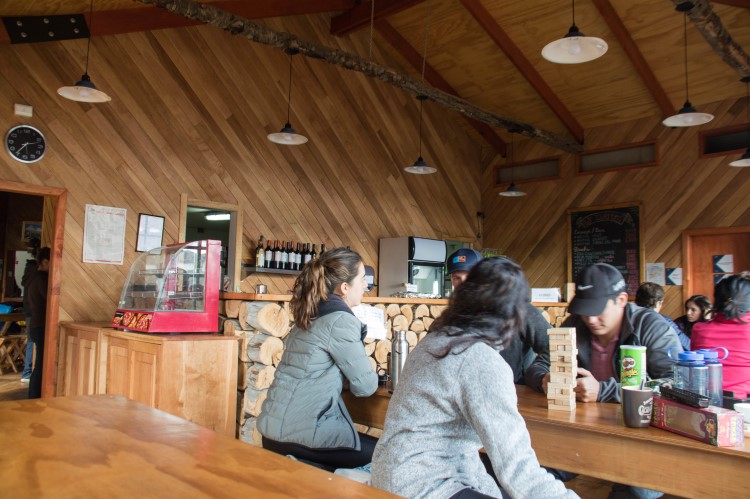
Stay overnight at Los Cuernos ($80,000 CLP ($88 USD) per person full board) instead of Francés
Again, this is only really possible if you stay overnight on Day Two in Paine Grande. When we hiked the Full Circuit, we decided to treat ourselves to an all-inclusive night at Los Cuernos.
This meant we still pitched our own tent on a wooden platform, but we had a three-course dinner, breakfast, and packed lunch for the next morning, which reduced the amount we had to pack in our rucksacks for the hike.
The food from Las Torres (previously known as Fantastico Sur) is much better than Vertigo Patagonia too, so I would recommend this instead of eating in the big canteen at Paine Grande.
Los Cuernos now offers camping sites without full board (previously you had to pay for full board at this campsite).
This means that for $25 USD per person you can pitch up your own tent here. They also offer half-board options priced at $62 USD per person, which include dinner and breakfast.
Book full board and a tent or bed at each campsite
You can rent gear and get food at all campgrounds, so if you don’t want to carry anything, then you can also book this way!
Bear in mind that full board at Los Cuernos comes in at $158 USD per person for a fully-equipped tent and full board – so it certainly won’t come cheap!
Did you find this guide to the Torres del Paine W hike useful? Pin it!
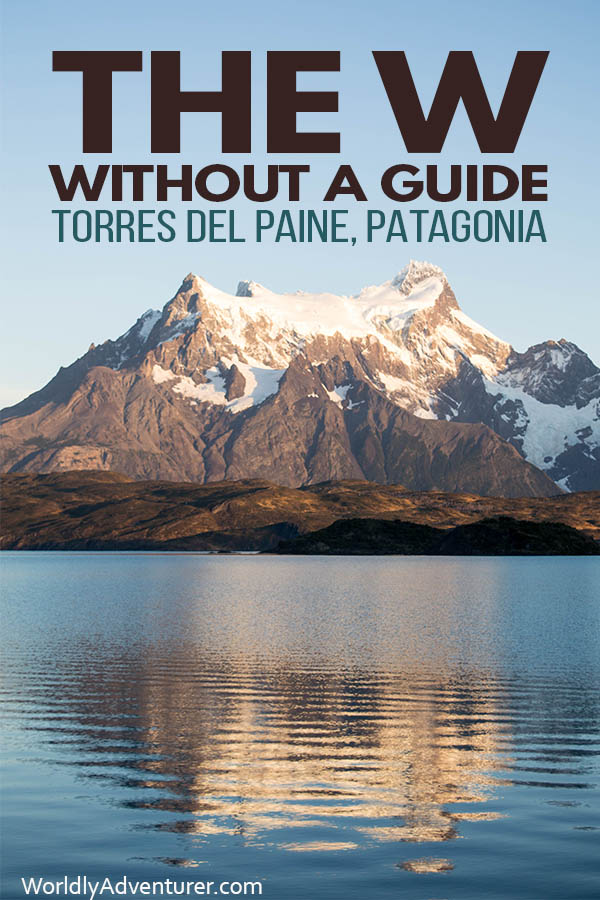
Rachel Dalton
Thursday 24th of October 2024
Hi there, thank you for this amazing resource. That being said, my partner and I unfortunately did not realize until now that you had to book so far in advance. We don’t have a booking yet and planning to go in end of January. There is still some accommodation available but a lot of the meal plans say they’re out of stock. If it’s listed as such is that the case? Or are there more flexible on allowing people with accommodation to pay for the meal plans upon arrival? If not, and we have to end up going with a tour is there one you recommend for the W trek?
Thanks in advance Rachel
Steph Dyson
Tuesday 29th of October 2024
Hi Rachel, I have heard of people requesting food when they arrive at the accommodation, but it is a bit of a risk. Could you not bring food with your for the hike? You can hire a camping stove/equipment in Puerto Natales, so could at least bring a couple of meals for where you can't get food. For tours, I recommend Chile Nativo (and they give a 5% discount if you mention Worldly Adventurer), but I think you should be able to get everything sorted without paying for a tour. Steph
Jas Morelli
Saturday 6th of April 2024
Thank you for this article super helpful!
I did have a question hoping for your advice. Our plans are to do the hike East to West, ending with the Catamaran. Instead of taking a bus back to PN right away, I have the idea to go spend the night at the campsite Lago Pehoe, spend one more day exploring and just relaxing by the lake then probably spend one more night there then head to Puerto Natales to reset before continuing our way towards El Chalten.
Would you recommend this idea? Have you visited that campsite?
There's just a few things I want to see before I leave that area like the boardwalk view from above the lake and walk the little red bridge.
Thank you for your help
Tuesday 17th of September 2024
Sorry it has taken me a while to respond. Yes, that seems doable and Bus Sur have buses between the different parts of the park (including a stop at Pehoe), which would make it possible to get from the Catamaran to the campground more easily (see here). I've camped in Pehoe and it's nice enough! Steph
Helen Turner
Sunday 4th of February 2024
Excellent article. Plenty of food for thought. Thankyou
Friday 9th of February 2024
Thanks Helen! Steph
Sunday 26th of November 2023
We were hoping to hike to Refugio Grey, then take the Navigation boat toward Hotel Grey, then take a shuttle to our car at Pudeto. But I'm not sure how the timing works out. If we take the 14:00 navigation from Refugio Grey, is there time to make the last shuttle from Hotel Grey?
Tuesday 28th of November 2023
Hi Karen, I'm not sure. You would need to go off the timings on the Hotel Grey website or reach out to them directly. Steph
Jonny Collins
Tuesday 24th of October 2023
Thank you for your brilliant blog posts on all things South America - they're perfect for someone like me that loves knowing the logistics of our upcoming trips! My wife and I were meant to visit Patagonia for the first time in 2020 as part of a wider trip that was cut short due to COVID - we read your blog posts at the time whilst planning. We're finally planning to visit in 2024!
Unfortunately due to work commitments we are not able to take more than two weeks off and it is making our itinerary from the UK quite tight (we want to get to El Calafete and El Chalten in the same trip).
Whilst I appreciate you recommend doing the W Trek in 4 or 5 days, we are considering doing it in 3 days (we are experienced hikers and have done multi day hikes before). We had always planned hiking West to East. For the most even split on distance it seems that staying at Paine Grande and Los Cuernos would work best. We're really keen to see the towers at sunrise but appreciate that staying at Paine Grande and Torre Norte to do this would result in a very big second day. We have thought of two alternatives:
Option 1 (West to East): Night 1: Campo Italiano Night 2: Torre Norte
Option 2 (East to West): Night 1: Refugio Chileno Night 2: Campo Italiano
We've not considered yet if these options work with bus and ferry timetables. Do you think either of the above options are feasible to do the hike in 3 days and get to see the towers at sunrise? If not is there an alternative that might work, or if we do the trek in 3 days do we need to accept that we would not be able to see the towers at sunrise?
Any advice on the 'best' way to do the W trek in 3 days would be much appreciated. Apologies if anyone has asked this before! Thanks in advance :)
Sunday 28th of January 2024
Hi Steph, Thank you for your reply. In the end we decided to find an extra day from elsewhere in the trip so that we could do the W Trek and not miss out on anything! Thanks again for your help and for keeping this brilliant blog post up to date!
Thursday 23rd of November 2023
Hi Jonny, Italiano isn't open any more unfortunately. I would recommend just doing day hikes rather than the W. That way, you can actually enjoy your day hikes and not worrying about trying to cover the ground quickly. Steph

- Best Hikes In The World
- Appalachian Trail
- European Hikes
- Nepal Hikes
- Patagonia Hikes
- See All Hikes
- Mount Kenya
- Mount Kilimanjaro
- Mount Toubkal
- See All Mountains
- South Africa
- New Zealand
- Switzerland
- United Kingdom
- Packing Lists
W Trek Patagonia – Guide To The Most Popular Hike In Torres Del Paine
Chile , Hikes , Patagonia , South & Central America
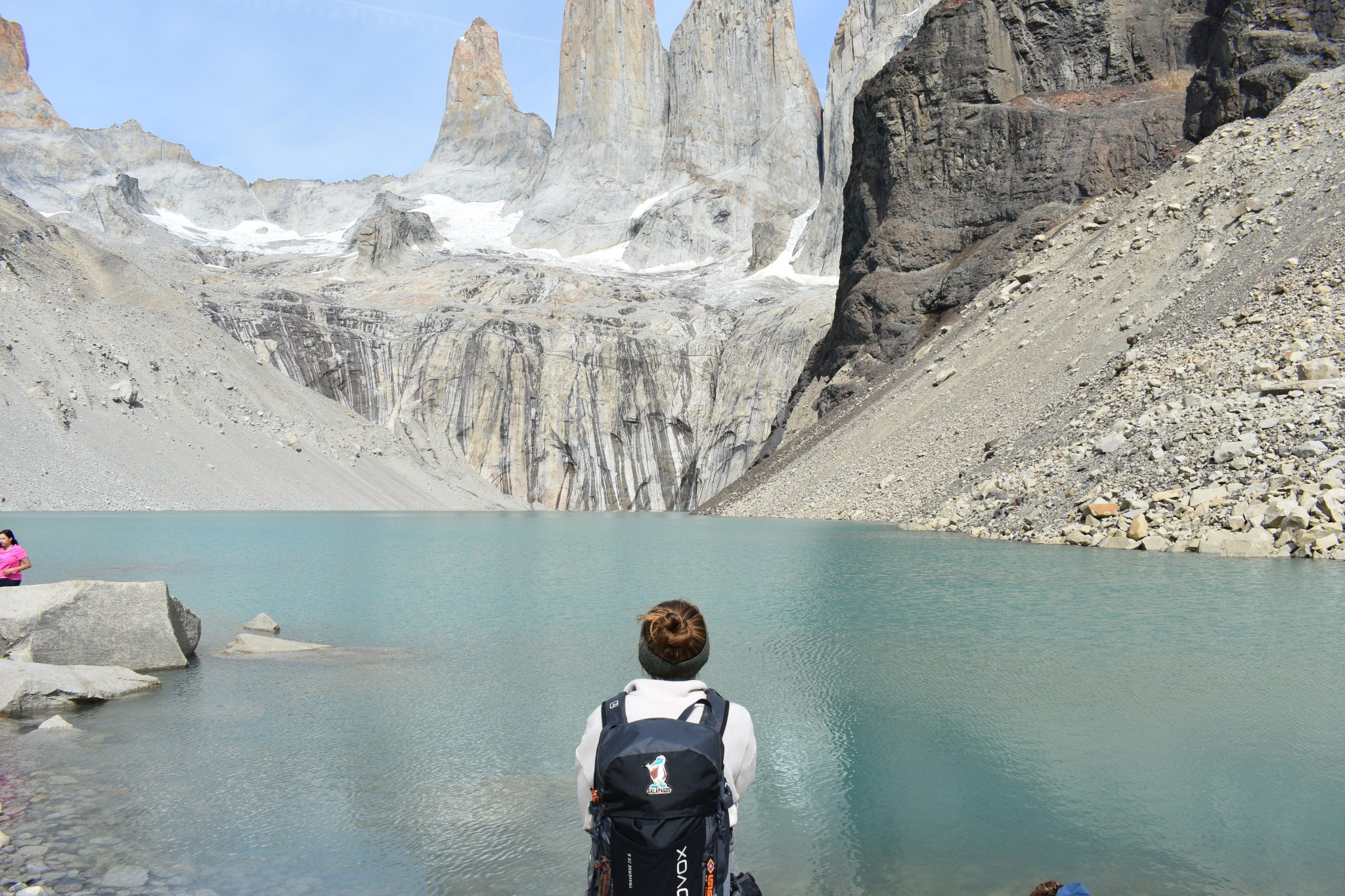
The Torres Del Paine W Trek in Patagonia is a 5-day, 100km adventure that brings you to some of the best features of Torres Del Paine. Visit Grey Glacier, the base of the Towers, the French Valley, and much more on this epic trek.
In this comprehensive guide, I'll go through everything you need to know about planning for and hiking this trail. I’ve also thrown in some up-to-date tips and links for booking campsites in Torres Del Paine.
Get ready to embark on the trail of a lifetime!
Why Hike The Patagonia W Trek?
See the highlights of torres del paine.
One of the main reasons why the W Trek in Patagonia is so popular is the stunning scenery that hikers encounter along the way. The route takes visitors past the park’s most popular features. See the granite spires of Torres del Paine, the turquoise waters of Grey Lake, and the vast glaciers that dominate the landscape.
An Accessible Trail If You Have Limited Time
Another reason why the W Trek in Patagonia is so popular is its accessibility. Unlike many other remote treks in Patagonia, the W Trek is relatively easy to reach and can be completed in a week or less. This is great if your Patagonian backpacking trip has a time limit.
Additionally, the W Trek offers several options for accommodations, from camping to refugios (mountain huts), making it accessible to a wide range of budgets and experience levels.
W Trek Patagonia- Know Before You Go
W trek in patagonia- location.
The Torres Del Paine W Trek is situated in Chile near the southern tip of South America. The park itself is located 112 km north of Puerto Natales and 312 km north of Punta Arenas.
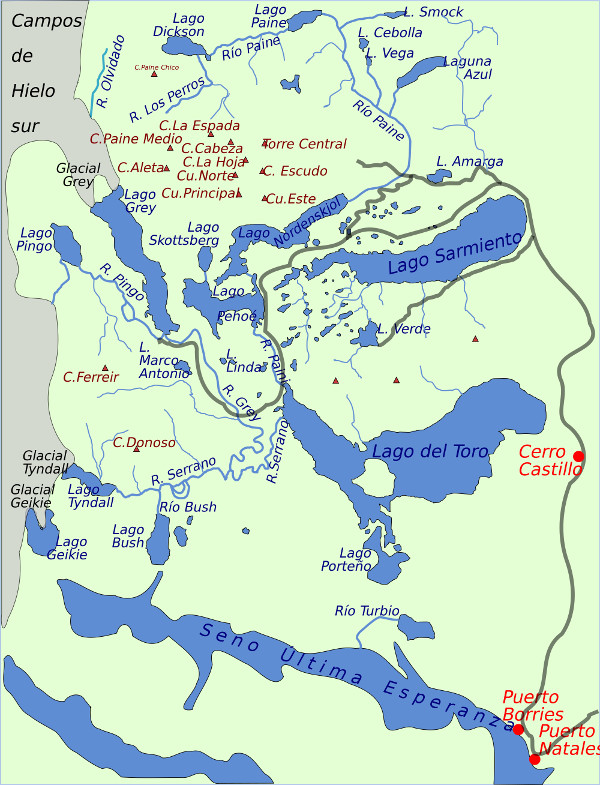
When is the best time to trek the W Hike Patagonia?
To highlight the pros and cons of each season, we have written a brief description of each below.
It’s worth also reading our articles on the best time to trek in Patagonia and, more specifically, when to hike in Torres Del Paine .
Spring - September to November
This is the perfect time of year to visit the park if you're wanting to experience warm, clear weather but without the huge crowds. Although not as warm as the summer months, the skies are often clear and you will get incredible views across the park. This is also the best season to see flowering flora in the region and witness the breeding season for wildlife.
Summer - December to March
This is the high season at Torres del Paine national park . Although the trails in Torres Del Paine are at their busiest, the weather is at its warmest. You'll get the maximum amount of clear days on your trek at this time of year. If you're the active type, then summer is also the period when you can horse ride, kayak, and mountain bike alongside your trek!
Fall - March to June
My favorite season without a doubt. The landscape becomes ablaze with color as the trails start to empty out and days become colder. The wind is often ferocious, but the spectacularly beautiful views are worth it!
Winter - June to August
Between May- September, self-guided hiking is not permitted in Torres Del Paine. Over this period, you can only hike Patagonia W Trek with a guide.
The major benefit of this season is that it is the quietest. There will be very few other visitors and you'll have many of the trails to yourself. This is the coldest period though and you will certainly experience cold nights and high, cold winds.
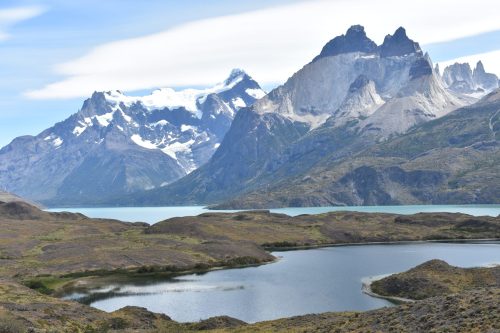
Torres Del Paine National Park
How Difficult Is Patagonia’s W Trek?
The Torres Del Paine W Trek is considered to be an easy multi-day trek as the elevation remains fairly steady throughout the hike. There is also the added benefit that the trek can be done over a longer or shorter period depending on your fitness levels.
Although regarded as easy, the trek still requires a solid level of fitness as you will be trekking a total of 100km/ 62 miles. This is 10-20km per day depending how many nights you camp out.
Hikers generally stay at the same elevation and certainly never go high enough for altitude sickness to become an issue.
The trails are well-defined and you’ll find signposts dotted along the trails at regular intervals. Water is available at all campsites, as is food. Ranger stations are dotted along the trail and you’ll most likely be among other trekkers (depending on when you trek).
Be careful though, storms are frequent in Patagonia and the wind can get extremely cold and strong. Always check weather forecasts before your day of trekking as the John Gardner Pass is often closed due to high winds.
Are Permits Required for The W Trek in Patagonia?
Yes, a permit is needed to enter the park. Permits cost $49 for more than three days. You need to book tickets online at least 24hrs before you visit.
You can print the permit or show it to officials on your phone. The park officials will need to see proof that you have booked your camping ground accommodation in advance.
Accommodation And Food On The W-Hike Patagonia
There are 11 campsites in the park which are run by three different companies. Currently, you can book campsites through Vertice Patagonia and Las Torres . Campsites cost between $10-$25 (Site only). Both companies also have the option to rent camping gear.
As well as tents, there is also options to stay in dormitories, cabins, and refugios. You can book these with the same companies mentioned above. I suggest using only one company to book your entire trek, for simplicity's sake.
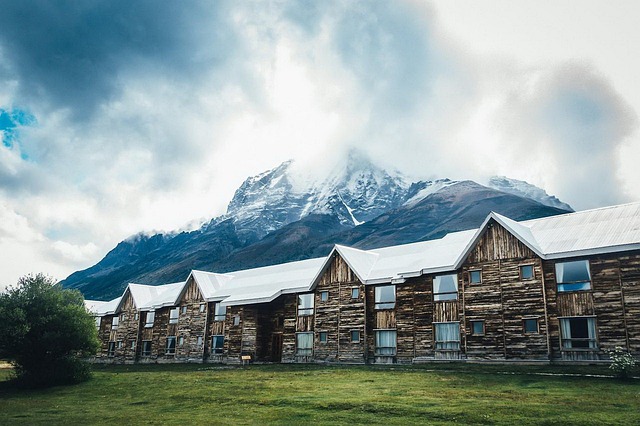
Hotel In Torres Del Paine National Park
At the camps, you will find bathrooms, shops, and even small restaurants. You may need to pre-order your meal so check beforehand.
Note: As of 2022/2023, the free CONAF campsites (El Paso and Italiano) are not available. It is unclear when and if these will re-open. It’s better to budget in paying for all your sites. If this has changed, please drop us a comment.
How Far In Advance Should You Book The W Trek, Patagonia?
Torres Del Paine treks are not something you can decide to do last minute. I’ve seen a friend break a sweat over finding campsites when she already had flights to Punta Arenas booked. This was a whole three months before her hike in November! To be safe, I’d say you should plan and book your trip at least six months in advance. Maybe even more if you plan on hiking the W Trek in the peak season (December-March)
Since 2016, the amount of people who can hike the W Trail is 80 persons per day. Visitors must reserve a place if trekking solo without an operator and you’ll need to take the trail in a counterclockwise direction.
How Do You Get To Torres Del Paine And The Start Of Patagonias W Trek?
Visitors can fly into Punta Arenas, Chile, or El Calafate, Argentina. From either of these towns. You can then take a bus to Puerto Natales.
The bus ride from Punta Arenas to Puerto Natales takes three hours and costs between $20-$30 dollars.
Buses between El Calafate and Puerto Natales are quite a bit longer (around 5 hours). Tickets cost between $30-$40.
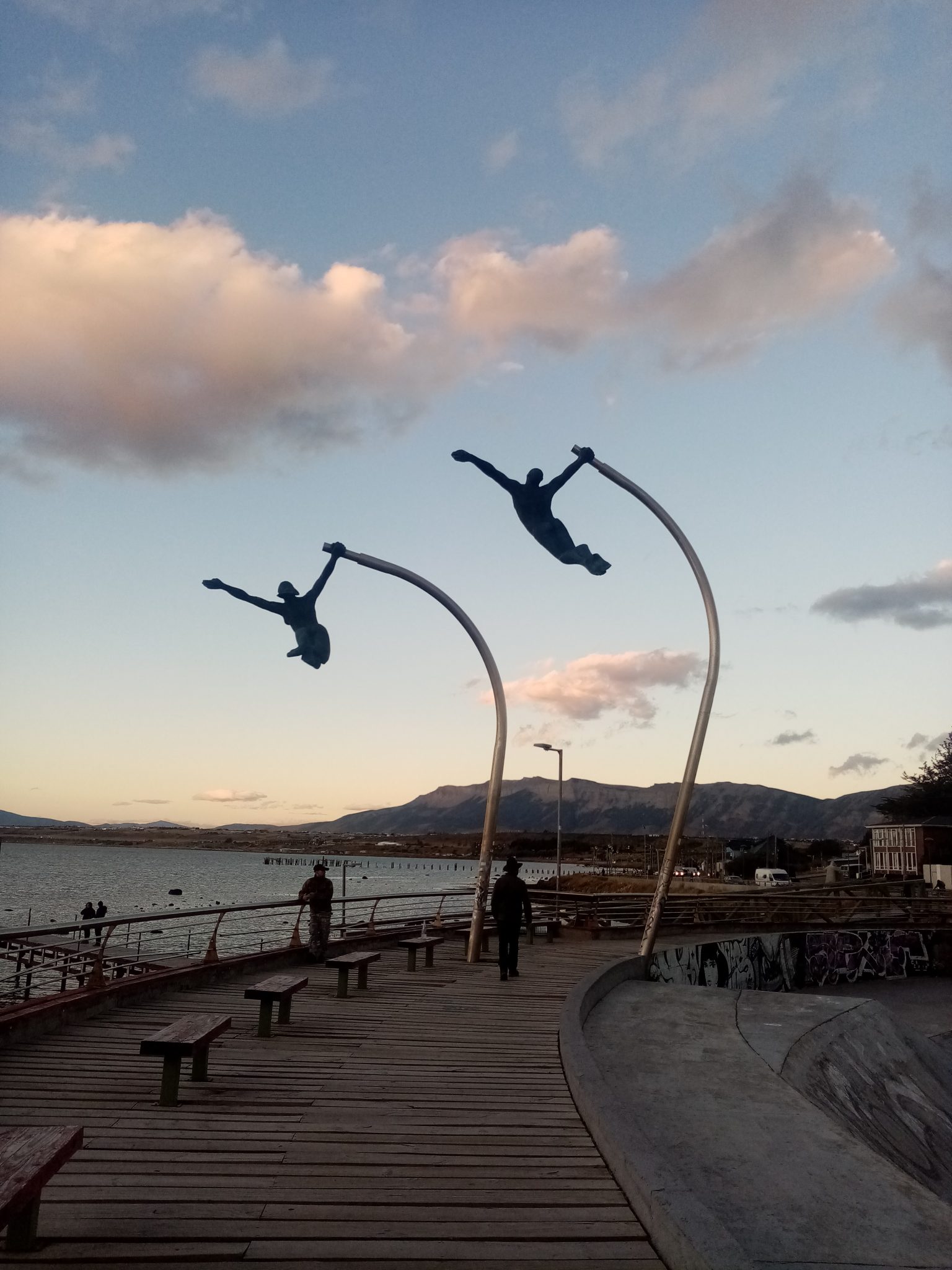
Its good to spend at least one night before the W Trek resting and exploring Puerto Natelensis
Daily buses run between the town of Puerto Natales to the entrance of Torres Del Paine. This ride will set you back $15-$15. If you have a higher budget, you could arrange a private transfer to the park and organize for the driver to pick you up after your trek.
How much does the W Trek Patagonia Cost?
The cost of a Torres Del Paine W Trek varies depending on when you book flights and when you trek (out-of-season tends to be a little cheaper). If you go with a trekking agency, local companies will be much cheaper than booking through an American or European operator. Trekking independently in Patagonia is always the most budget-friendly choice.
- Tour Agency: ~$500 for a cheap local agency to ~$2,000 for a pricey Western trekking agency
- Visa, Vaccinations, Insurance etc:~$300-$500
- Equipment (buying and hiring):~$500-$800 – camping gear can be rented at the park entrance for $200.
- Return flights to Punta Arenas: ~$1,500
- Tips: ~$10-20
- Misc (additional food, unplanned travel/hotels, etc): $50
Total costs with tour agency: $2,000 – $4,000 It is possible to plan an independent W trek for less than $300. This price includes food, park entrance, and camping (assuming you have your own equipment). Food can be purchased from refugios throughout the park, however, it is very expensive.
You may also like : Guide to Fitz Roy hikes
Hiking The W Trek Patagonia - Route Guide
The most popular trek in Patagonia , the Torres Del Paine W Trek is fast becoming one of the most well-respected short hikes in the world due to the trail's stunning scenery.
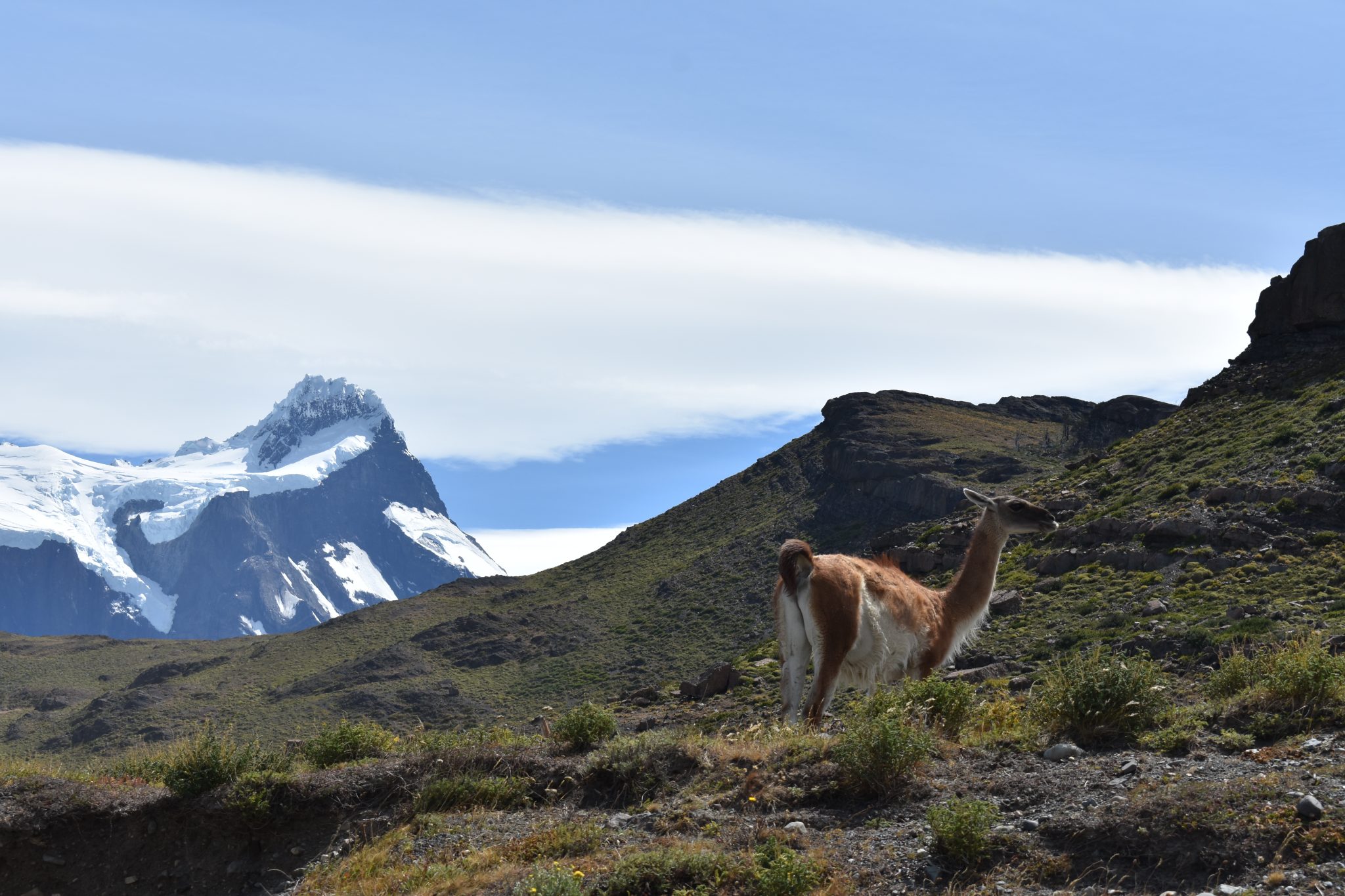
Guanaco in Torres Del Paine
Located in the amazing Torres del Paine National Park which was made a World Biosphere Reserve by UNESCO in 1978. The 100km trek generally takes around 5 days to complete. It takes visitors into the very heart of the park, through haunting forests, soaring mountains, and colossal glaciers.
Where does the W Hike Patagonia Start And End?
The trek begins with a lovely boat ride near the Grey Glacier and finishes with a magical sunrise at the famous Torres on the final morning. There is the option to do the longer full circuit O trek , however, most travelers opt for the shorter W Trek.
Patagonia W Trek - Day By Day Trail Information
Below is a standard, 5-day itinerary outline for your Torres Del Paine W Trek. This can vary depending on fitness levels, available camps, and routes. It should at least provide a good idea of what to expect. This is especially useful if you are trekking Patagonia independently .
Day 1: Puerto Natales to Refugio Grey (11km)
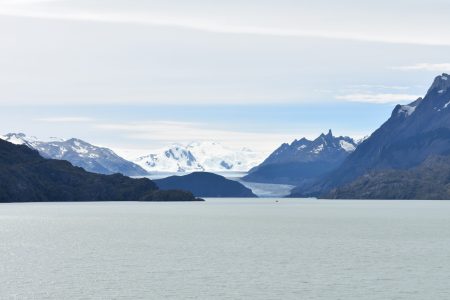
Grey Lake with Grey Glacier in the background, the start of the W Trek
Leave early from the town of Puerto Natales. Buses depart at 7:15, if you go with a tour or taxi, you will probably leave earlier.
Take your transportation Pudeto. This is the next stop after the park entrance.
If you have time, visit the local waterfall and take some pictures. You then take a lovely boat ride by catamaran to Paine Grande. After arriving you begin your trek in earnest with a 3-4 hour (uphill) hike along Lago Grey to Refugio Grey where you camp the night. If you have some energy after dinner, head down to the lake and feel the cold water!
Day 2: Grey Glacier to Paine Grande (19km)
Today you’ll be up early – around 8 am – to hike up to the former campsite of Paso. From the campsite, you take a small path to the lookout platform where you get stunning views across Grey Glacier.
After spending a little time appreciating the glacier, you have the option to continue the hike to Paso.
This is an uphill trek and will add extra mileage to your day. However, I’d recommend it as the trail is absolutely beautiful and gives incredible views all the way along the glacier.
After visiting Paso, return along the trail back down to where you camped the previous night.
After lunch, it is a 3-4 hour hike down to your next campsite at Paine Grande. If you can, find a campsite next to the hill so you’re not battered by the strong winds overnight.
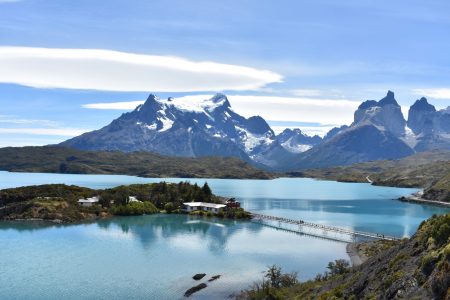
Refugio Paine Grande lies at the other side of Laguna Pehoe
Day 3: Valle del Frances to Los Cuernos (28km)
Today is a long one! Mentally prepare yourself for a full day of hiking. You begin your trek around 8am and hike for several hours until you reach camp.
At the camp, you should dump your large backpack at Campamento Italiano and head on up to Mirador Frances with your daypack. Take your lunch with you along with water and sunscreen.
The walk takes 2-3 hours and you should reach the Mirador around lunchtime.
After stopping to eat and explore the area, you’ll head back down to Campamento Italiano and retrieve your large backpack.
From there you head to your next campsite at Los Cuernos. This is roughly 2 hours walk away.
Day 4: Los Cuernos to Campamento Torres (20km)
This is the last full day of hiking on the circuit. After a leisurely breakfast, you should head off around 9 am towards Campamento Chileno.
Your trek begins on flat ground as you make your way along the Lago Nordernskjöld. After a few hours, you’ll come to a sign saying “shortcut to Chileno”.
Take the shortcut and walk for several hours until you reach the Refugio Chileno. Have lunch here before continuing on.
After lunch, you will walk uphill for an hour or so until you reach Campamento Torres. Leave your large backpacks here and head upwards for 45 minutes until you reach the Torres! Take a well-deserved break and soak in this iconic view.
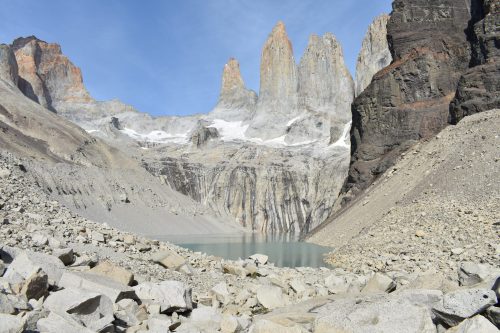
A steep climb up is rewarded with this view of the Iconic Las Torres granite spires
Back at the Refugio, make sure you hit the sack early. You’ll need to be up before sunrise the following day!
Day 5: Torres to Puerto Natales (10-15km)
Don’t sleep in on Day 5! You’ll want to rise early (around 5 am) to get the sunrise views at the mirador of the Towers. Sunrise happens around 6 am in summer and there is just a short walk to the viewing and picnic area. If you’re lucky with the weather, you’ll get an incredible view and witness one of the most beautiful sunrises on our planet! If it’s raining in camp, do not give up – the weather is frequently very different up near the viewing area and the weather can clear fast. It’s worth taking a chance. After your sunrise moment, head back down to camp and pack up all your gear. From camp, you will head down to the Hotel Las Torres. This walk takes roughly 3 hours. From the trail’s end, you can walk to the park entrance. The 7km/ 4.3 miles will take you around 1.5 - 2hrs. At this point, you will be exhausted and may prefer to take the 2 pm minibus to Laguna Amarga at the entrance. Its worth budgeting an extra $10 for this bus fee. The return bus to Puerto Natales leaves at 2:30 pm from the park entrance. Double-check bus times before you set off.
W Trek Patagonia Map
The best map I've found for the Torres Del Paine W Trek is the Torres del Paine Waterproof Trekking Map by Sergio Zagier. The map provides compressive satellite relief, contour lines, shelters, timed trails, camping, and inns.
Other W Trek FAQs
Is altitude sickness a risk on the w trek.
There is essentially zero risk of altitude sickness on the Torres Del Paine Full W Trek. The highest point reached is under 700 meters which is far too low to bring on altitude sickness. See our guide on altitude sickness .
What W Trek guidebook do you recommend?
The one guidebook that stands above all others is Trekking Torres del Paine: Chile’s Premier National Park and Argentina’s Los Glaciares National Park by Rudolf Abraham. The guidebook covers eight major trails within the park including the Full Circuit and the ‘W’ Trek. Maps, tips, and detailed information is provided for each trek and the book is a must for trekkers hiking solo.
What gear do you need for the W hike?
Trekking the W requires a certain amount of essential pieces of trekking clothing and equipment.
Many pieces of equipment including tents, sleeping bags, and mats, can be rented at the campsites. However, rental prices are high. We recommend bringing the most important pieces of gear with you.
To help you plan and prepare for your trek we have written a detailed hiking gear list .
About the author
Alison Macallister
With a degree in Nature Conservation and experience working with wildlife including the Big 5, Alison used to work as a guide for a 5-star safari reserve in South Africa. Today she is a full time traveller and editor for Mountain IQ. She has travelled and hiked extensively in South America, including many solo hikes in Patagonia, the Cusco region of Peru, Ecuador and Chile.
Leave a Reply
Your email address will not be published. Required fields are marked
We work with local guides to offer great value adventures at unbeatable prices
Everything you need to know about the Torres del Paine W Trek
W Trek is the most popular and most celebrated route in Chilean National Park Torres del Paine. Its name comes from the shape the trek draws on the map and it can be completed in 3-5 days . The W Trek is almost 50 miles (80 kilometers) long. It is considered moderately difficult; the total elevation gain is 8,956 feet (2,730 meters), and unlike the O trek, the W trek is open all year .
However, if you come to Torres del Paine during the winter season, you can only do the W Trek with a guide. You can walk the W Trek in two directions , either from east to west or from west to east. Both options have some pros and cons, but the great thing is that whichever direction you decide to walk, you will not miss any of the breathtaking views.
Torres del Paine W Trek map
How many days do i need for the w trek.
We strongly advise allocating 4 or 5 days , with 3–4 nights spent in campsites or refugios in the Torres del Paine, to fully enjoy everything W Trek has to offer.
If you don't have much time, you can still complete the W Trek in 3 days. In that case, be prepared for a tough walk and a busy schedule. Alternatively, you could skip some of the sights along the W Trek.
The points of interest along the W Trek
The W Trek takes you to some of Chile's most stunning locations. It usually begins or ends (depending on the hike’s direction) in the Ascencio Valley with the Base Torres lookout , then continues through the famous French Valley (Valle Francés), located in the heart of Torres del Paine, where you can truly appreciate the amazing Patagonian nature. And don't forget about Grey Lake and the Grey Glacier , where you can see massive icebergs falling from the glacier's base.
Torres del Paine Ascencio Valley
Ascencio Valley leads to one of the park's most iconic sights, the Base Torres , also known as Mirador las Torres. The valley is characterized by its dramatic landscape and changing scenery, surrounded by steep, craggy mountains. This part of the trek gets tough due to the steep ascents and rocky terrain.
The Base Torres (Mirador las Torres)
The Base Torres is, without a doubt, the goal of most of the visitors and is also what the park is named after. Once you reach the Base Torres viewpoint, you are rewarded with one of the most spectacular views in the park; three distinct peaks of the Towers of Paine rising above a turquoise glacial lake.
Torre D'Agostini (also known as the South Tower), Torre Central, and Torre Monzino (also known as the North Tower) stand more than 8,200 feet (2,500 metres) tall.

Torres del Paine French Valley
The French Valley (Valle Francés) is one of the highlights of the Torres del Paine. It's situated between the highest peak in the Paine Massif, Cerro Paine Grande, with its hanging French Glacier , and Los Cuernos peaks. The route follows the French River through beech forests to Mirador Francés and Mirador Británico, where you can enjoy spectacular views of the surrounding peaks.
When planning this portion of the hike, keep in mind that the French Valley route (from Camp Italiano to Mirador Británico) is not open 24 hours a day . Typically, it closes in the afternoon. It means you have to start this portion of the trek before that. The closing time varies, so you may need to check when you arrive at the park.
French Glacier
The French Glacier (Glaciar Francés) is one of the most remarkable features of the French Valley, and it can be observed from certain points along the trail. French Glacier, like many glaciers in Patagonia, is active . This means it regularly calves large chunks of ice into the valley below.
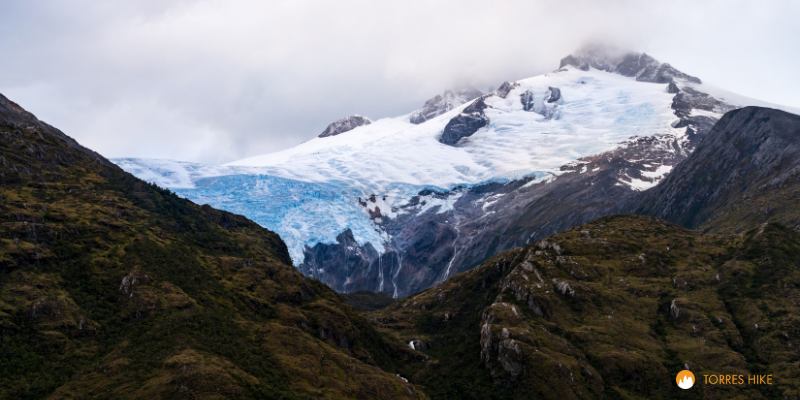
Los Cuernos
Los Cuernos, also known as the Horns , is a breathtaking mountain formation known for its horn-shaped granite peaks and multicolored contrast due to the various types of rocks. It can be viewed from several locations along the northeastern shore of Lake Nordenskjöld .
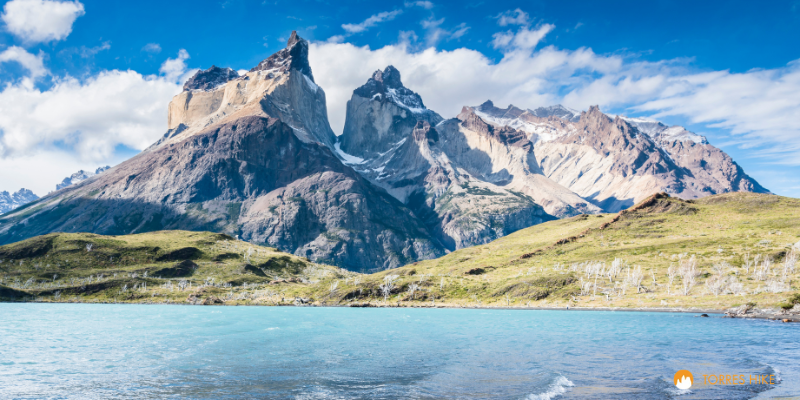
Grey Glacier
A massive glacier is one of the most visited sights in the park. It is part of the Southern Patagonian Ice Field and measures about 30 meters high and 6 kilometers wide. It’s located in the western part of the W Trek and can be best observed from several viewpoints. You'll discover the most popular one near Refugio Grey .
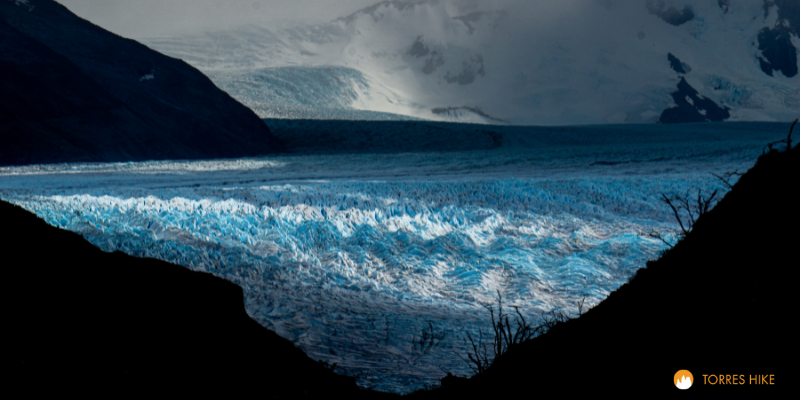
How to walk the W Trek
This is the eternal question. Is it better to hike the W Trek from west to east or from east to west? In our opinion, it makes little difference . The west-to-east direction is more popular. It also allows you to witness the sunrise at Mirador las Torres (if you spend the night in Chileno). However, if you do not need to go there early in the morning to catch the sunrise, base your decision on logistics and personal preferences.
W Trek West to East
This direction follows the counter-clockwise path from the park's west to the east.
Points to consider
Gradual difficulty : Starting the trek on the west side allows for a more gradual increase in difficulty. In the beginning, the terrain is relatively easy, giving you more time to become accustomed to walking each day.
The best for last : If you consider the Base Torres to be the park's highlight, save this experience for your final day.
Transportation : It’s often easier to start the trek in the west because of the catamaran from Pudeto to Paine Grande.
W Trek West to East suggested itinerary for 5 days/4 nights
This itinerary should give you an idea of where to make your reservations and the distance on each day, but you can always alter it to suit your needs.
Day 1: Grey
- Take a bus from Puerto Natales, which departs at 7 AM from the Puerto Natales Bus Terminal. Have your tickets and passports checked at the park's entrance (Laguna Amarga station), where the bus stops. The bus then continues to Pudeto. The website BusSur.com provides an updated bus schedule. We recommend buying bus tickets in advance, either online or at the bus terminal.
- From Pudeto, take a catamaran across Lake Pehoé to Paine Grande. The catamaran waits for the bus connection, and tickets can be purchased on the spot. Payment is only accepted in cash. The website Catamaranpehoe.com provides more information about the catamaran.
- From Paine Grande walk to Camping & Refugio Grey.
Total walking distance: 11 kilometers
Day 2: Paine Grande
- To see the Grey Glacier, walk from Camping and Refugio Grey to Mirador Grey.
- Walk to Paine Grande and stay the night.
Total walking distance: 18 kilometers
Day 3: Cuernos/Francés
- Start trekking from Paine Grande through the magnificent French Valley all the way up to Mirador Británico. Keep in mind that the route from Camp Italiano to Mirador Británico is not open all day and if you want to go there, you need to start your hike in the morning. It is better to check the closing time at the park, as it varies.
- Return from Mirador Británico and spend the night either at Francés Camping or in Cuernos. In Cuernos, you can make reservation for a refugio, camping, or mountain cabin, depending on the availability.
Staying in Cuernos
Total walking distance: 23 kilometers
Staying in Francés
Total walking distance: 20 kilometers
Day 4: Torres Central & Norte/Chileno
- Walk all the way to either Torres Central & Norte or Chileno. If you want to hike to Mirador las Torres the next morning to catch the sunrise, make your reservation in Chileno.
Staying in Torres Central & Norte with previous night in Cuernos
Total walking distance: 13 kilometers
Staying in Torres Central & Norte with previous night in Francés
Total walking distance: 16 kilometers
Staying in Chileno with previous night in Cuernos
Total walking distance: 14 kilometers
Staying in Chileno with previous night in Francés
Total walking distance: 17 kilometers
- Hike to the Mirados Las Torres and see the famous Towers del Paine.
- Walk back to Torres Central & Norte, where you can catch a shuttle bus to the park entrance and from there, take a bus back to Puerto Natales. Laguna Amarga is the name of the station at the park entrance. Before finalizing your plans, check the bus schedule online , as it varies depending during the low and high seasons.
Previous night in Torres Central & Norte
Previous night in Chileno
Total walking distance: 15 kilometers
W Trek East to West
This direction follows the clockwise path going from the park´s east to the west.
Starting strong: If you begin at the east, you will tackle the most challenging parts of the trek in the first two days and then you can relax more and enjoy relatively easy terrain.
Less crowded: More people choose to head in the opposite direction. This can sometimes mean that you will see fewer hikers in the early morning.
W Trek East to West suggested itinerary for 5 days/4 nights
Day 1: Torres Central & Norte/Chileno
- Take the bus from Puerto Natales, which departs at 7 AM from the Puerto Natales Bus Terminal. Get off at the park's entrance (Laguna Amarga) to have your tickets and passports checked. The website BusSur.com provides an updated bus schedule. We recommend buying bus tickets in advance, either online or at the bus terminal.
- Take a shuttle from the park entrance to Torres Central & Norte. The shuttle leaves at the same time as the bus from Puerto Natales arrives.
- Depending on where you made your reservation for the first night, either drop your gear in Torres Central & Norte and head towards the Mirador las Torres and back or walk to Chileno to check in and go to Mirador las Torres and then back to Chileno to spend the night.
Staying in Torres Central & Norte
Staying in Chileno
Day 2: Cuernos/Francés
- Go from Chileno or Torres Central & Norte all the way to either Francés Camping or Cuernos. In Cuernos, you can make reservation for a refugio, camping, or mountain cabin, depending on the availability.
Staying in Cuernos with previous night in Torres Central & Norte
Staying in Cuernos with previous night in Chileno
Staying in Francés with previous night in Torres Central & Norte
Staying in Francés with previous night in Chileno
Day 3: Paine Grande
- Hike through the French Valley all the way to Mirador Británico. Keep in mind that the route from Camp Italiano to Mirador Británico is not open all day and if you want to go there, you need to start your hike in the morning. It is better to check the closing time at the park, as it varies.
- Return from Mirador Británico and continue to Paine Grande, where you spend the night.
Previous night in Cuernos
Total walking distance: 23 kilometers
Previous night in Francés
Day 4: Grey
- From Paine Grande walk to Refugio and Camping Grey where you can drop your gear and head further north to the Mirador Grey to get a better view of the Glacier Grey. Then return to Grey for the night.
- Walk from Grey to Paine Grande.
- Take the catamaran to Pudeto. Check the catamaran schedule on Catamaranpehoe.com website. Payment is only accepted in cash.
- From Pudeto, take the bus to Puerto Natales. Check the bus schedule on BusSur.com .
How difficult is the W Trek?
The W Trek is considered moderately difficult, but this can vary. It really depends on your experience, fitness level, and the weather conditions.
Every day, you walk for 6-8 hours and cover a distance of approximately 9-12 miles (14-20 kilometers). In addition, the terrain in the French Valley and the hike to Mirador las Torres are steep and physically demanding for those unfamiliar with multi-day hiking.
Remember that the weather in Patagonia can be unpredictable, and you may experience sun, rain, snow, and winds all on the same day. That means you must be prepared and have the proper equipment.
The good news is that there are many accommodation options along the way where you can at least take a break. Also, the trail is well marked, and the park is frequented by hikers, making it difficult to get lost.
W Trek accommodation and opening dates for season 2024/2025
Camping Grey (Vertice Patagonia) - opens on October 1st
- Check in 1 PM/Check out 9:30 AM
- Capacity for 120 campers (camping)
- Shared bathrooms, hot water showers, food service, designated cooking area, restaurant, bar, mini market
- Possible to rent sleeping bags, sleeping mats and tents
Refugio Grey (Vertice Patagonia) - opens on October 1st
- Capacity for 60 guests
- Bunk beds and single beds with mattress cover, pillow and pillowcase, shared bathrooms, hot water showers, food service, designated cooking area, restaurant, bar, mini market
- Possible to rent sheets and blankets
Camping Paine Grande (Vertice Patagonia) - opens on October 1st
- Capacity for 260 campers
- Shared bathrooms, hot water showers, food service, designated cooking area, restaurant, bar, mini market, cafeteria
Refugio Paine Grande (Vertice Patagonia) - opens on October 1st
- Capacity for 100 guests
- Bunk beds and single beds with mattress cover, pillow and pillowcase, shared bathrooms, hot water showers, food service, designated cooking area, restaurant, bar, mini market, cafeteria
Francés Camping (Las Torres Patagonia) - opens on September 15th
- Capacity for 120 campers
- Shared bathrooms, hot water showers, designated cooking area, restaurant, food service, bar, mini market
- Possible to book a tent with or without sleeping bag or just a camping spot
Cuernos Camping (Las Torres Patagonia) - opens on November 1st
- Capacity for 90 campers
Cuernos Mountain Hostel (Las Torres Patagonia) - opens on November 1st
- Capacity for 32 guests
- Bunk beds with fully made beds, shared bathrooms, hot water showers, designated cooking area, restaurant, food service, bar, mini market
Cuernos Mountain Cabins (Las Torres Patagonia) - opens on November 1st
- Capacity for 16 guests
- Private cabins (maximum capacity 2 people), fully made beds, towels, shared bathrooms, hot water showers, firewood heater, designated cooking area, restaurant, food service, bar, mini market
Chileno Camping (Las Torres Patagonia) - opens on September 15th
- Capacity for 30 campers
- Shared bathrooms, hot water showers, designated cooking area, food service, restaurant, bar, mini market
Camping Central (Las Torres Patagonia) - opens on September 15th
- Capacity for 250 campers
- Shared bathrooms, hot water showers, designated cooking area, restaurant, bar, mini market, food service
Central Mountain Hostel - Torres Central & Norte (Las Torres Patagonia) - opens on October 1st
- Bunk beds with fully made beds, shared bathrooms, hot water showers, designated cooking area, restaurant, bar, mini market, food service
When is the best time to hike the W Trek?
In general, the best time to visit Torres del Paine National Park is during the summer months , which in Chile are December through February. The weather is milder, the days are longer, and everything is open, including campsites and restaurants. The park is bustling, and there are numerous hikers. However, if you prefer to visit the park during the off-season while still having access to the majority of the facilities, come in April . The rates can be slightly reduced, and it is much easier to find available accommodations.
From November until early December
Patagonia's spring will be your favorite season. The park is a little less crowded, wildflowers are blooming, and nature is awakening. However, the weather can be unpredictable.
Mid-December to February
Definitely the peak season. The weather is warmer; however, the trails and accommodations are usually crowded.
It is still considered the peak season, but the crowds begin to thin out as time passes. It's a popular time for those who want to enjoy the park with fewer visitors.
As autumn approaches, the park becomes less crowded, and the landscape bursts with autumn colors. However, the weather cools and the days get shorter. We recommend this time of year for more experienced hikers.
What to pack for the W Trek?
Packing for the W Trek requires careful consideration of the changing weather conditions. It also depends on whether you're renting camping gear, staying in refugios, etc. Check out this list of essential items to pack for the W Trek in Torres del Paine National Park.
Backpack: A comfortable and durable backpack (40-70 liters) is ideal for transporting all of your gear. However, if you have reservations for refugios or tents with sleeping bags and have also made meal reservations, a smaller backpack for your clothing will be adequate.
Clothing: Keep in mind that the weather in Patagonia can be unpredictable, so pack at least two sets of clothing. You may get wet during the day, so have a spare set of clothes to keep you dry and warm at night. To protect your clothes, consider using a plastic bag or waterproof case. Here are some suggestions for what you might need.
- Base layers: moisture-wicking underwear and thermal base layers for warmth
- Outer layers: waterproof and windproof jacket and pants
- Trekking pants
- Fleece or down jacket
- T-shirts: both short-sleeved and long-sleeved for layering
- Quick-drying underwear and socks
- Gloves and a warm hat
- Sturdy, waterproof and broken-in hiking boots with ankle support
- Gaiters to keep dirt and moisture out
Gear (if staying in the camp most of the time)
- Sleeping bag (suitable for low temperatures)
- Sleeping pad to provide insulation and comfort. Even during the summer, temperatures in Torres del Paine can drop significantly at night. The ground can be very cold, and a sleeping pad provides a barrier between you and the ground, keeping you warm throughout the night.
- Headlamp and extra batteries
- Trekking poles (only if you are used to trekking with them)
- Multi-tool or knife
- Water purification method (iodine tablets or a filter)
Cooking and eating
- Lightweight stove and cookware
- Freeze-dried meals or lightweight food
- Snacks (nuts, energy bars, dried food)
- Water bottle or hydration system
Personal items
- Insect repellent
- Toiletries (toothbrush, toothpaste, biodegradable soap)
- First aid kit
- Dry bags or plastic bags to keep clothing and electronics dry
Miscellaneous
- Permits, identification, and confirmations about the reservations
Keep in mind that the key to comfort is layering, as the weather can change rapidly. Remember to pack light, as carrying too much weight can make your trek more challenging.
Have any further questions about the W Trek? Ask away .

IMAGES
VIDEO
COMMENTS
The W trek is a multi-day hiking route in the Torres del Paine National Park in Patagonia, Southern Chile. It’s one of the most famous treks in the region. How long is the trek? The total distance of the W trek in Torres del Paine is 100 km/62 miles. To hike it takes 4 or 5 days.
The W Circuit is the most popular hike in Torres del Paine National Park for a reason – it’s stocked with all the highlights including Las Torres Base Viewpoint, Los Cuernos Mountains, Francés Valley, Paine Grande and Grey Glacier .
The W is a four- or five-day hike in Chilean Patagonia’s Torres del Paine National Park. It’s named the W because it follows a W-shaped route and can be hiked either from west to east (my preferred route) or from east to west.
The Torres Del Paine W Trek in Patagonia is a 5-day, 100km adventure that brings you to some of the best features of Torres Del Paine. Visit Grey Glacier, the base of the Towers, the French Valley, and much more on this epic trek. In this comprehensive guide, I'll go through everything you need to know about planning for and hiking this trail.
The Torres del Paine W Trek in Patagonia is one of the most famous hikes in the world – and for good reason! It is absolutely breathtaking from beginning to end. However, booking and planning your trip on the W Circut in Torres del Paine National Park isn’t easy.
The ultimate guide to hiking the W Trek in Torres del Paine. Get insider tips, packing essentials, and must-see sights for your Patagonian journey.